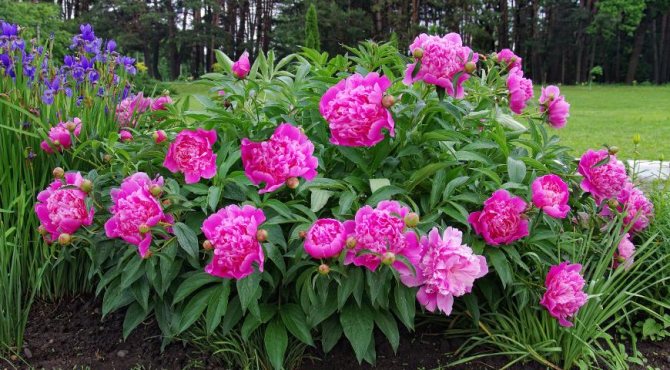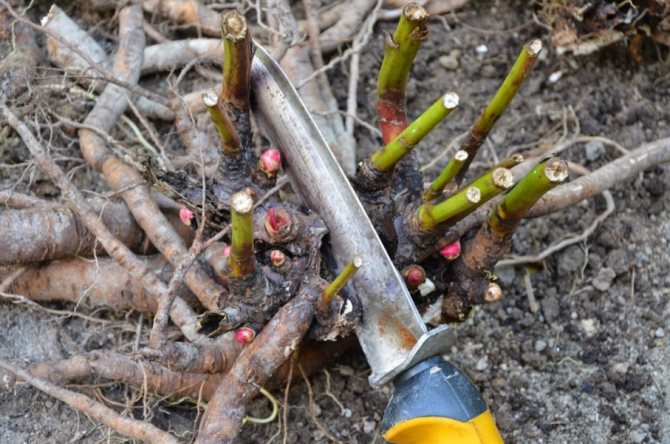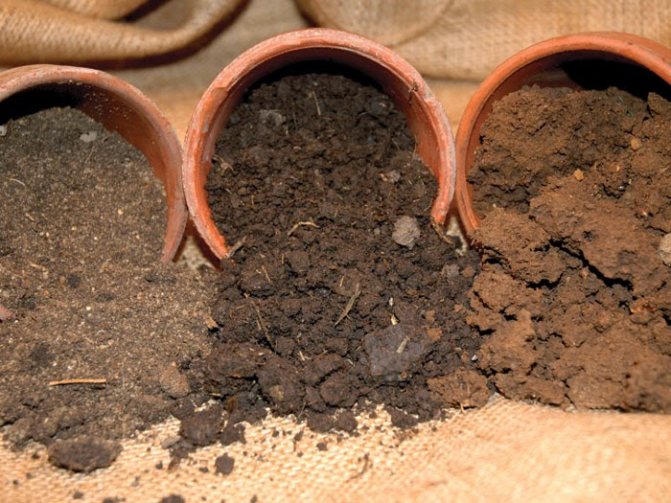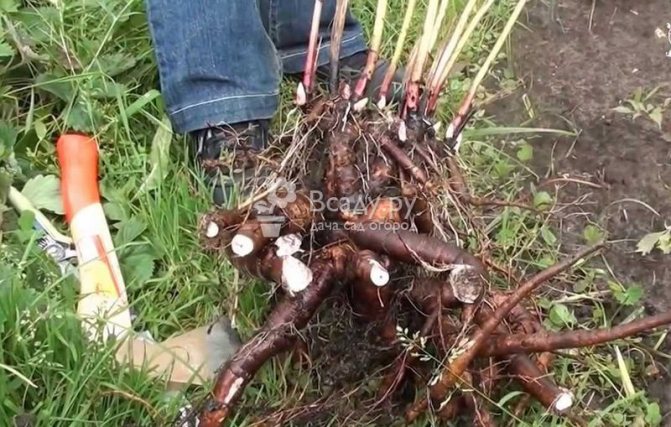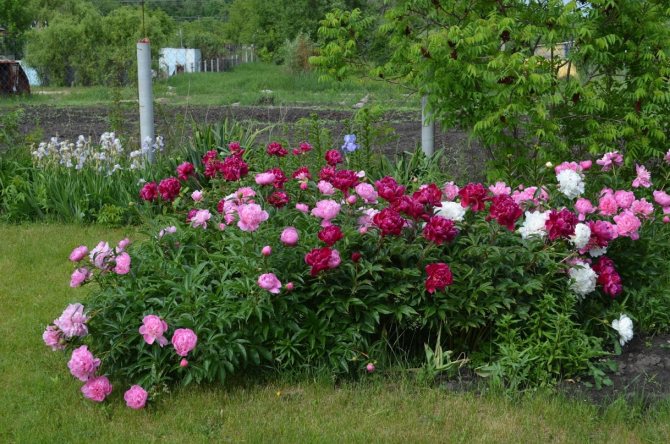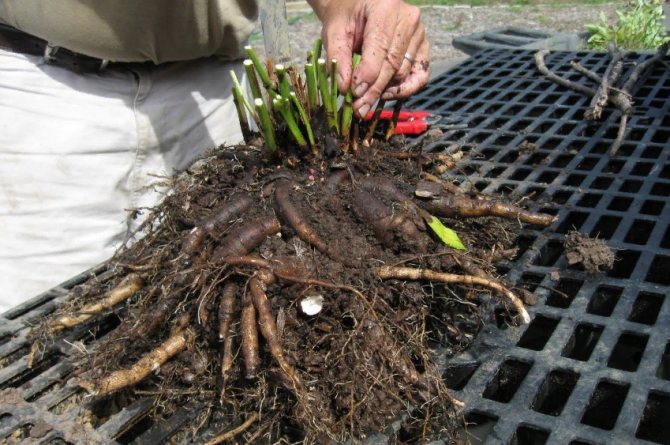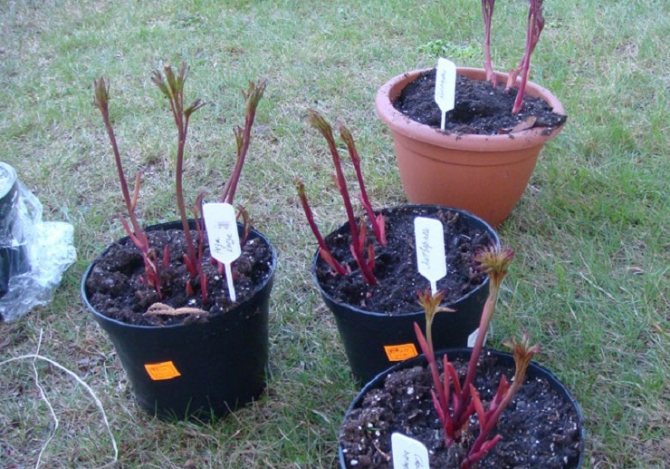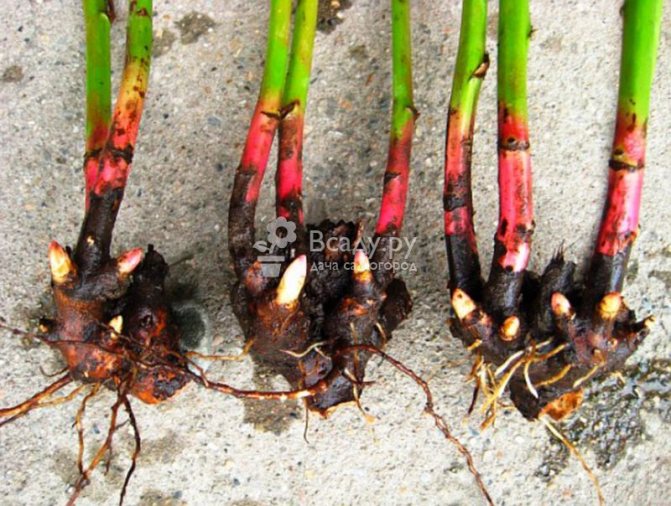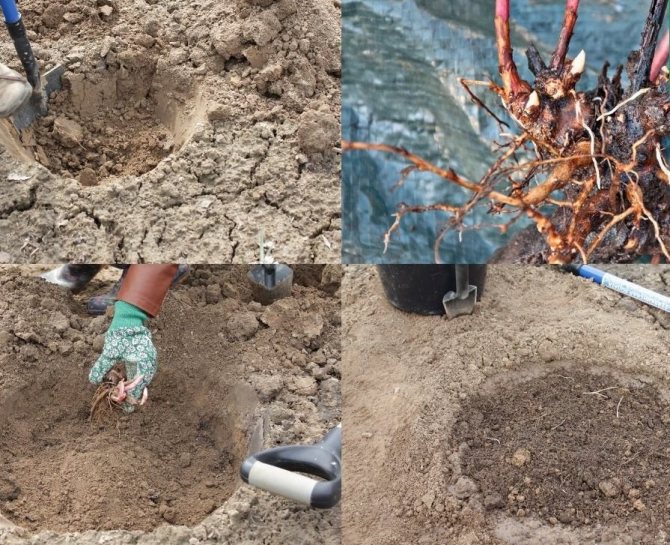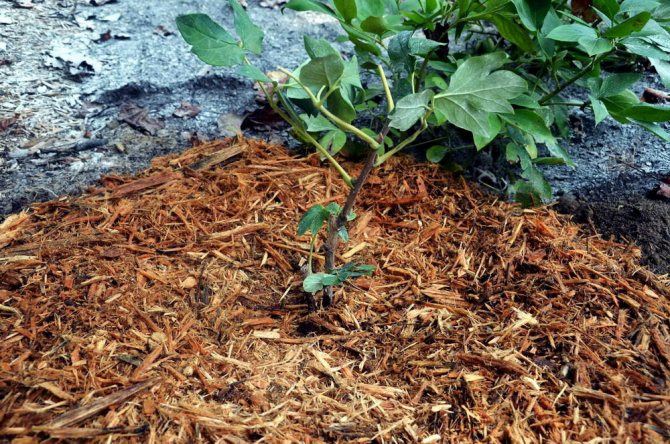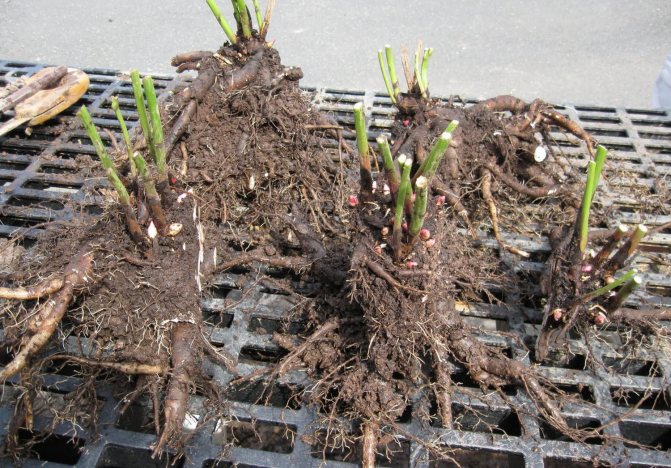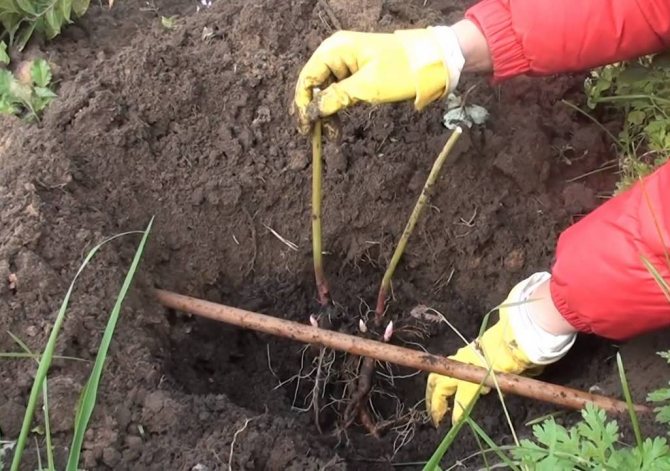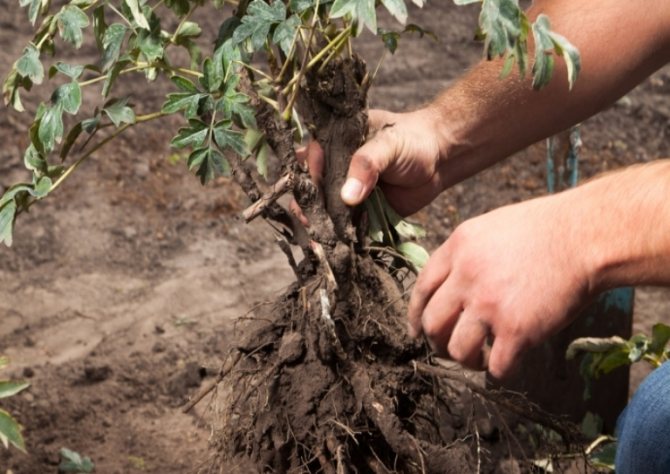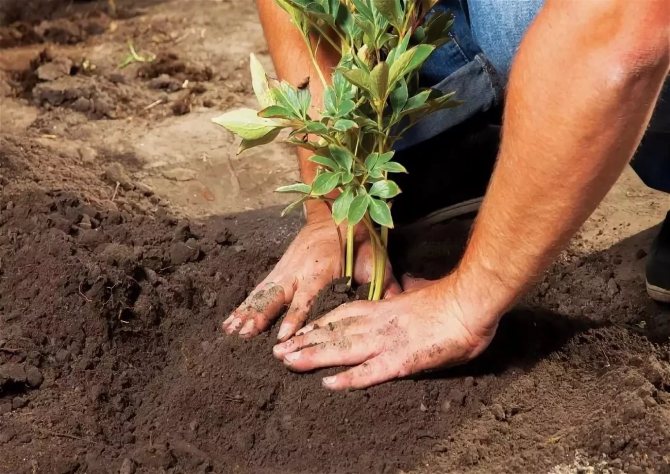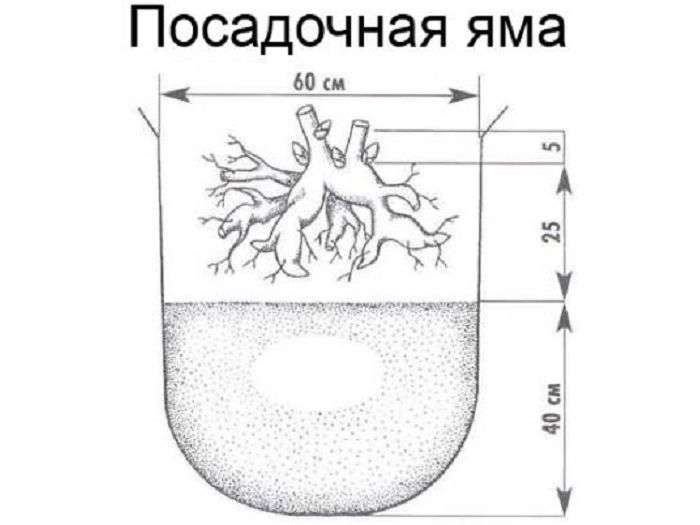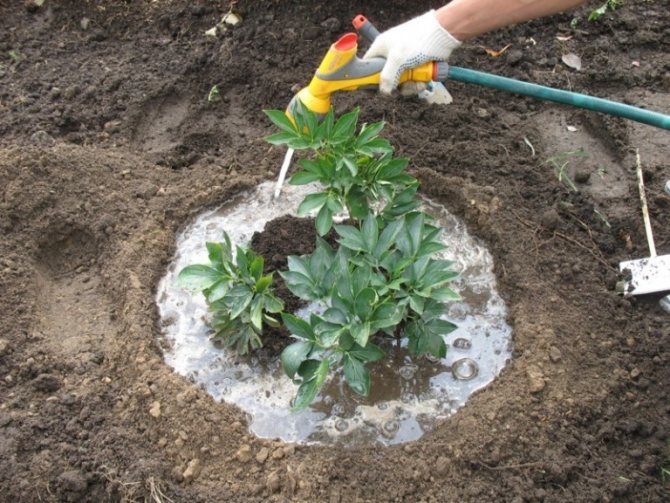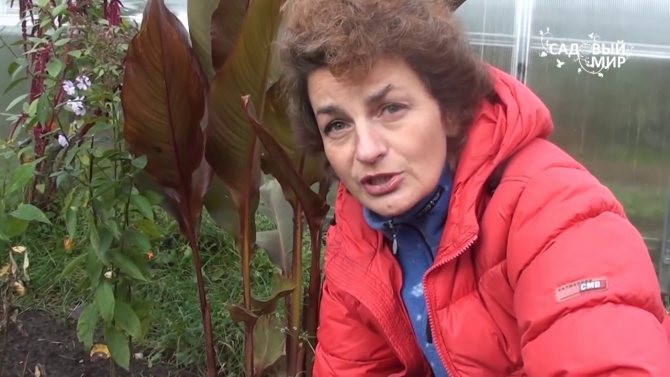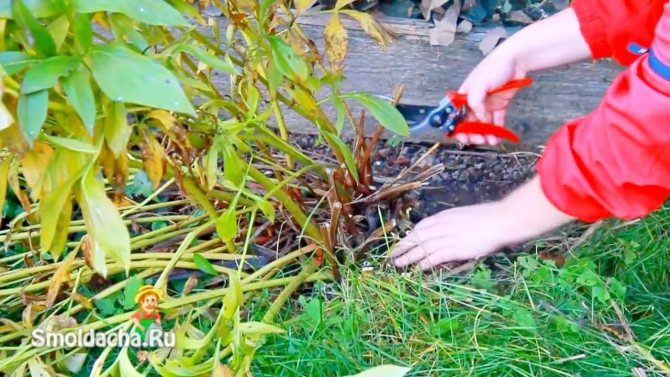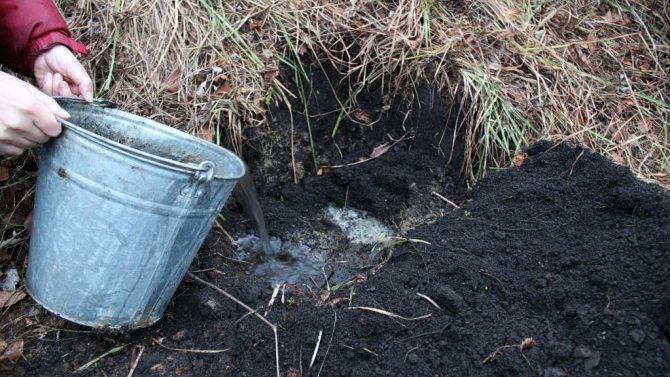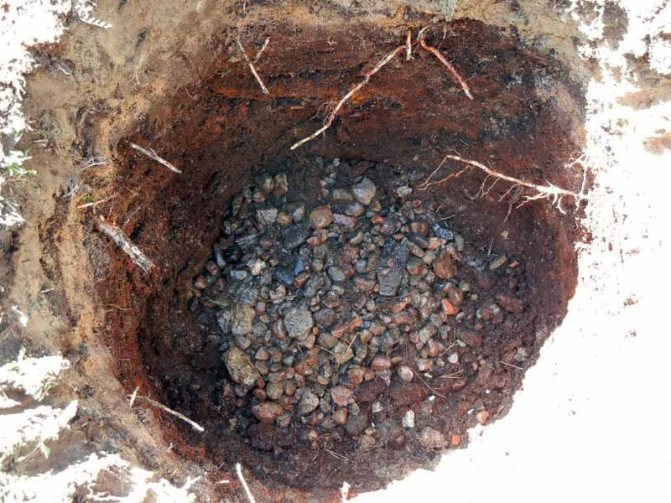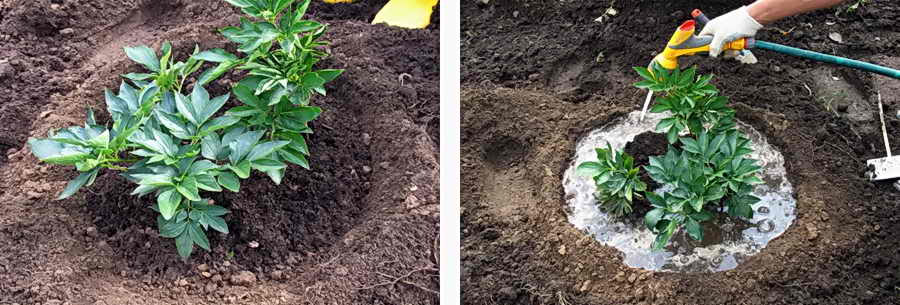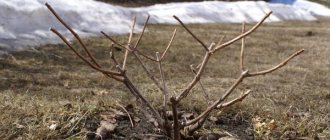Peonies are lovely spring flowers. They are great in a variety of colors and shapes. So that they grow wonderfully lush and fill the garden with a fragrance, you should work hard when planting them. You will learn from this article about when it is optimal to plant peonies in autumn in different regions of the country, about the peculiarities of planting them in open ground, as well as about leaving after planting and typical mistakes of novice summer residents.
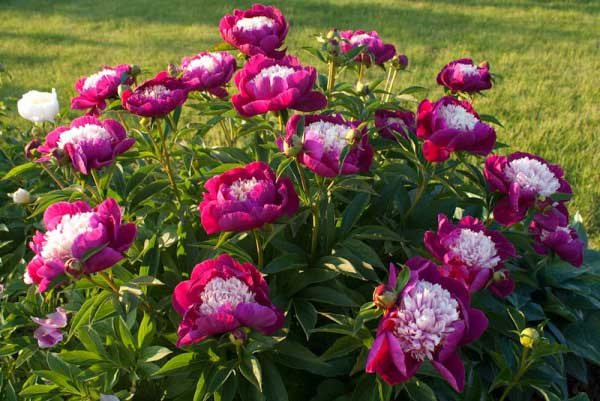
We transplant peonies correctly


With proper care, peonies can grow for many years.
In the history of peony breeding, plants are known that have “lived” without transplanting for 50 or even 100 years. But these specimens are a rare exception to the rule. Since the bulk of peonies without transplanting begins to degenerate after 5, maximum 12 years after planting a young plant. Moreover, the more decorative the variety, the more demanding it is to change the place of growth.
The fact that it is time to transplant a peony can be understood by the appearance of the plant. The stems become thinner, there are many tops without flowers, the flowering becomes moderate, and the flowers themselves are smaller. This is due to the aging of the root collar. As soon as rotten hollows begin to appear in this part of the flower, insects immediately inhabit them, which accelerates the decay process. This leads to the fact that every year the plant lays buds deeper and deeper and spends more energy on germination than on the formation of a crown and a flower.
REFERENCE: "Depending on the variety of peony, it is advisable to transplant and divide the bush every 6 (in some cases 12) years."
Peonies are very unpretentious plants, but there are still certain rules for planting them.
Growing seedlings
When growing seedlings of peonies in winter, after sowing, they are stratified in 2 stages: warm, then cold.
Stratification is an artificial adjustment of seeds for growth by keeping them in a moist substrate and at a certain temperature difference. Warm stratification is carried out at positive temperatures for 1-2 months.
With cold stratification, the seeds are kept at a temperature of 0 ... 5 ° C for more than 1 month.
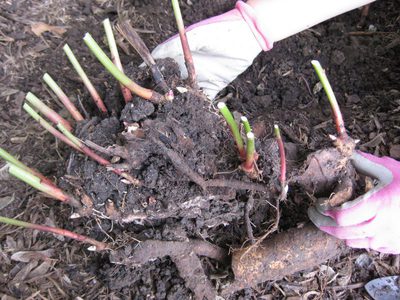

For peonies, warm stratification is carried out at a daytime temperature of 30 ° C, at night it is reduced to 15 ° C. At the cold stage, the seeds of peonies are transplanted into peat cubes and the temperature is lowered to 5 ... 10 ° C. When the first leaves appear, the temperature is raised to 18 ... 20 ° C. To maintain the required temperature, an electric heating pad with a thermostat is used. Containers with seedlings are installed on it. For comfortable seed growth, the topsoil is constantly moistened.
When shoots appear, the lids are removed from the containers and the seedlings are placed on a well-lit windowsill. When the first true leaves appear on the peonies, the plants dive.
Planting peonies with seedlings is rare. The usual way of breeding them is by dividing the bush. The right time when you can replant peonies ensures good growth and abundant flowering. Plants in this case can not be transplanted for 7 years.
Preparing a place for a peony
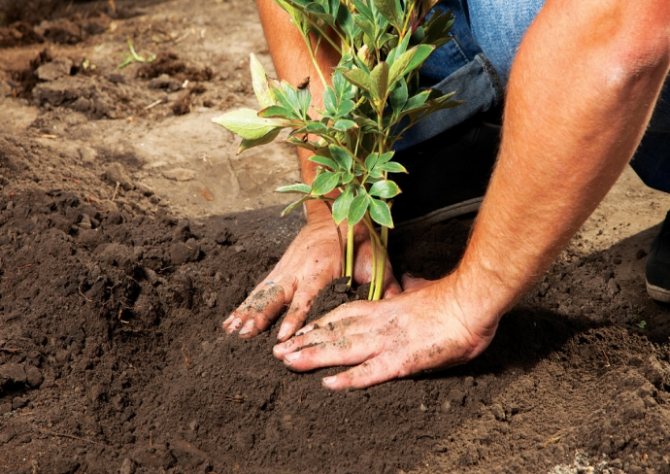

When choosing a new place for a peony, you especially need to pay attention to lighting.
The homeland of the peony is the subtropical belt. They are widespread throughout the northern hemisphere from East Asia to North America.This explains the need for peonies in a temperate climate, good lighting and moderately fertile soil. Therefore, when choosing a place for a flower, you need to pay attention to the following features:
- Sunlight must constantly flow to the plant.
- Drafts and strong winds make the bush weak.
- Groundwater should not lie closer than 1 meter from the surface.
- It is better to select areas with a high clay content in the soil.
REFERENCE: “When choosing a place for planting, you need to remember that the bush will grow here for about 10 years. Its location should not interfere with the further development of the garden. "
After choosing a place, you need to prepare the holes. Experienced gardeners say that it is better to dig holes 10 days before the upcoming peony transplant. The flower does not tolerate moving soil, the earth in the hole should be well established.
Site preparation for planting
Knowing the peculiarities of growing this ornamental culture, it is easy to create favorable conditions for its growth on your site. What peonies love:
- Soil with medium moisture content. Excess moisture, like its lack, negatively affects the health of the root system. It is advisable to place the flower bed on a low hill.
- Bask in the sun. It is necessary to equip a flower bed on an area that is well lit by the sun. Planting next to buildings or large trees from which a shadow falls is unacceptable. In light partial shade, only undersized bushes grow well.
- Places protected from northerly winds. Large trees, a fence or buildings act as protection. But they should be located on the north side. You can't close the south side - the sun is shining from there and it's warm.
- Fertile loam with good drainage is the best soil for growing peonies. In a flower bed filled with loam, plants grow rapidly and bloom early.
Digging up peonies
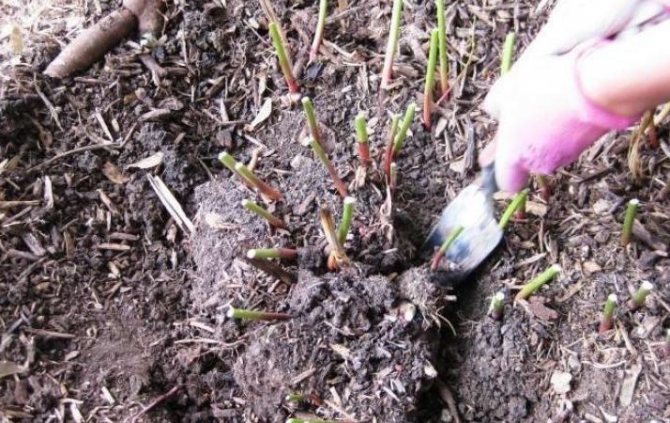

When digging, you need to be very careful with the roots of the plant.
To begin with, digging up a peony is a laborious task, requiring both accuracy and remarkable strength from the gardener. Adult peony bushes have a fairly powerful root system. The main roots go into the soil by almost a meter.
Before digging up, the aerial part of the plant is cut off. The tops are cut at a distance of 5 centimeters from the ground. Then, using a garden shovel, mark the boundaries of the future pit. The shovel is inserted into the ground at an angle of 90 degrees at a distance of no closer than 20 cm from the bush. After digging, they continue to dig the bush with a garden pitchfork.
REFERENCE: "When digging up peonies, you must not turn out blocks of earth with a shovel, as you can damage the lateral roots."
Do not worry if the bush has crumbled into several parts. This suggests that the root neck of the mother plant has aged and the flower has long needed planting. But you cannot separate the root of the plant yourself. The buds are poorly visible in the ground and can be easily damaged.
How to dig up bushes?
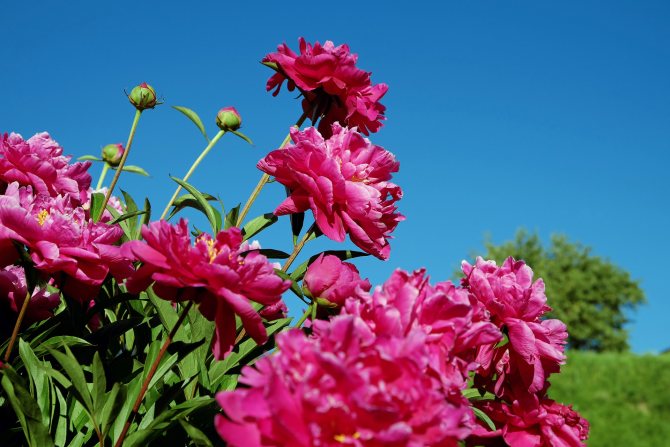

If the age of the bush reaches four, five or more years, then its roots are already quite powerful and deep (80-90 cm). Moreover, they are quite gentle and can be easily injured by rude, inept actions. Therefore, you need to dig out a peony as carefully as possible. The sequence of actions is as follows:
- Dig in the ground around the plant within a radius of 40-50 cm. The older the bush, the greater this distance should be. It is best to dig in the plant not with a shovel, but with a pitchfork: it is safer for the flower. After the bush is dug in, you need to gently loosen it and remove it from the ground with the help of two shovels.
- Rinse the roots with a jet of water.
- Cut off the aerial part of the bush at a height of 4-6 cm.
- Put the plant in the shade for several hours so that the roots become softer during this time.
Before planting, old bushes need to be divided, so the plants rejuvenate. To separate the bushes, they should be dug up. Before digging, the peony stems are cut above the soil level.The petioles are left 8-10 cm high. The bushes should be dug out very carefully.
The bush is carefully dug in around the perimeter, stepping back 20-30 cm from its base. Forks are better suited for this process. When digging up bushes, they damage the rhizome and young shoots that have formed over the summer less.
The dug-up bush is carefully loosened with a pitchfork. At the same time, scrap is used for heavily overgrown bushes. The dug-up bush is carefully removed from the soil, pushed with a crowbar and pitchfork, and left in the shade for 2-3 hours for easy drying of the roots. This allows them to be less brittle.
With a wooden peg with a blunt point, the root system of the dug out bush is cleaned of adhering earth. Then the rhizome is washed with warm water, while being careful not to damage the thin roots. The root system is examined for rot and disease. Sick and rotten roots are cleaned with a sharp knife. The old roots are pruned by about 10-15 cm. The undercut angle is 45-60 °.
Divide the peony bush
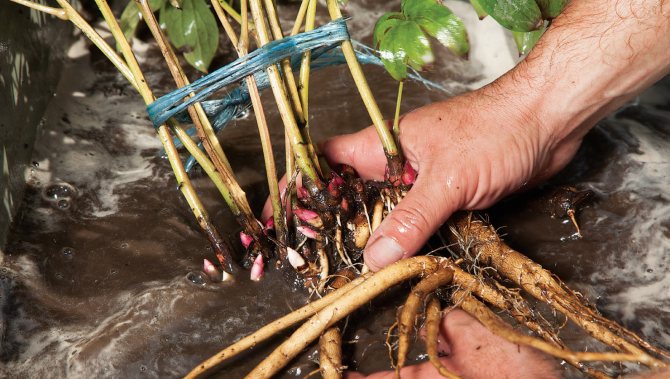

Before dividing, you should thoroughly wash off the soil from the rhizome.
The rhizome is carefully washed in running water under low pressure. And so that the soil is better washed out, the roots can be pre-soaked in water for half an hour.
The washed peony roots are left to wither in the shade for about a day. After this procedure, the roots become more flexible and do not break. Then you can go directly to dividing the bush:
- Small bushes are divided with a sharp knife, bulky rhizomes are broken using a stake. The peg is inserted into the center of the root collar and the bush is divided along natural faults.
- Small parts of the rhizome should be examined carefully. Remove rotten, dry and damaged areas. Healthy roots are pruned at a distance of 20 cm from the neck. It is advisable to divide the rhizome so that each piece has 3 to 5 buds. Smaller delenki are also viable, but such bushes will bloom a year, or even two years later.
- To keep the planting material from fungi and pests, the prepared parts of the root are kept for a couple of hours in a strong solution of manganese and powdered with crushed charcoal. Of the drugs, it has proven itself well "Heteroauxin". They can process the roots before planting in the ground. The solution is made at the rate of 2 tablets per ten-liter bucket.
- The finished parts are dried again until a thin crust is formed.
After the performed procedures, the peony cuttings are completely ready for planting. But if it is not possible to immediately plant the plant, it is enough to dig in the resulting parts of the root shallowly in a shaded place.
Purchase of planting material
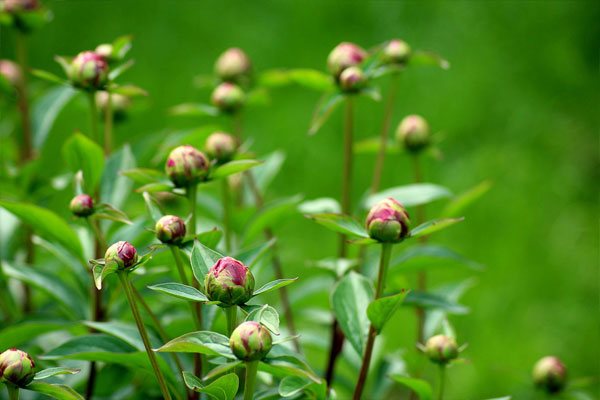

It is advisable to buy roots for planting in local nurseries. Usually they have a wide selection of planting material, so there should not be any difficulties with the acquisition. Nursery plants quickly take root in a new location and immediately adapt to the local climate. How to choose the right division for planting:
- High-quality cuttings are dense to the touch, without damage or rot. The presence of an unpleasant odor is unacceptable.
- A good planting material has at least 3 lignified shoots about 20 cm long.
- The minimum number of adventitious roots is 2 pieces. The length of the roots should not be less than 5 cm.
- The shoots should have at least 3 healthy buds. By the time of planting, they should be unblown, dense and glossy.
How to properly transplant peonies to bloom profusely
Transplanting peonies is a simple matter. But in order to get a beautiful bush that retains its decorative qualities and delights with its lush color, you need to follow a number of tips drawn up by leading botanists and experienced gardeners.
Future place
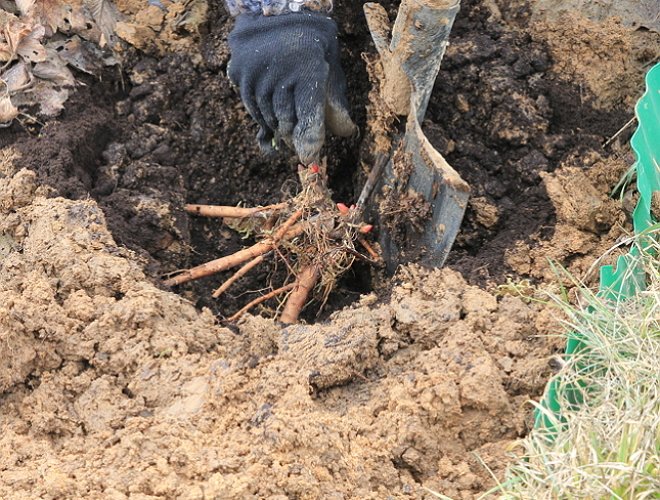

The further development of the plant depends on the choice of location.
Sunlight must constantly flow to the plant. The more, the better.Peonies can also be planted in areas shaded at midday. But in this case, you will not have to expect lush flowering.
Most varieties of peonies belong to the category of herbaceous plants. They do not tolerate strong winds and drafts. In such areas, the tops quickly lose their decorative properties.
You also need to take into account that this plant loves abundant watering, but does not tolerate moss and soils with a high occurrence of groundwater.
Plant soil
It's hard to imagine, but this delicate flower grows much better on heavy soils. Peonies can be called one of the few plants that prefer clay, but fertile soil. Peonies do not take root well on sandstones and do not tolerate acidic soils.
Distance between colors
The distance from one hole to the other will largely depend on the design idea and "preferences" of a particular variety. In general, these are quite tall (up to 1 meter) and spreading plants. Therefore, the transplantation of peonies to a permanent place should be carried out in holes located at a distance of at least 50 cm from each other.
Planting depth
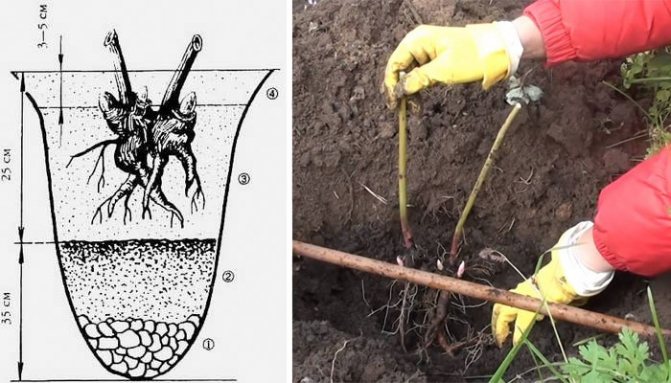

General scheme of landing depth
The size of the hole depends on how the peony will be transplanted. If it is necessary to transplant an adult bush, a cube with an edge of about 80 cm is dug.When planting in an area with a high occurrence of groundwater, the hole should be deepened by another 20 cm and drainage should be built.
When planting an adult plant, by dividing the mother rhizome, the size of the hole can be reduced to a cube with an edge of 40-50 cm. The main thing is that the roots of the plant do not have to bend when planting. Also, you need to take into account that the peony does not like excessive deepening.
Popular varieties of herbaceous peonies
- Lilac Mist - a small diameter bush consists of long peduncles with 2 or 3 buds. Flowers up to 15 cm in diameter. The color of the flowers is lilac-pink.
- Red ball - from the name it is clear that the flowers have a dark red hue. The bush itself is low (up to 85 centimeters), but densely leafy. Blossoming of the variety "Red ball" falls on the month of June.
- Siberian Souvenir - the maximum height of the bush is 90 cm. On long and strong peduncles there are double and very lush white flowers. Single specimens reach 15 cm in diameter.
- White Novosibirsk is a fast-growing herbaceous variety of peony. The stems reach a height of 90 cm. In the process of growth, the shrub retains its compact shape due to the vertical arrangement of the stems. On each stem there are peduncles on which flowers of a white shade bloom with yellow stamens in the center.
This list of varieties is incomplete. Only the most frost-resistant varieties, adapted to cold climates, are presented here. They grow well in Siberia and the Urals. In the southern regions, you can plant thermophilic varieties with other decorative properties (larger flowers or rather lush bushes).
Peony transplant instructions
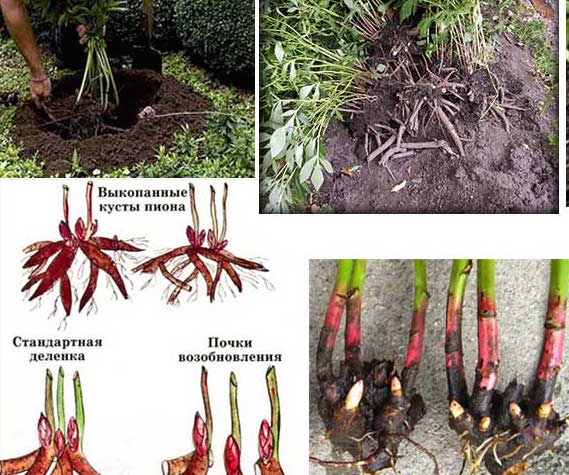

Peonies are great for both organic and complex fertilizers. Compost and mullein are placed in the hole immediately after preparation. On the day of planting, add a glass of superphosphate and potassium sulfate.
These flowers prefer soils with neutral pH. When planting a cut in acidic areas, add a faceted glass (without a slide) of slaked lime to the hole.
When planting plants in areas with closely located groundwater, it is necessary to make good drainage. Otherwise, the roots of the peony will quickly lock up and rot. Branches, sand and broken shards are used as drainage means.
Excessively heavy soil can be drained with coarse sand. On sandy and black earth areas, a little clay is added to the hole. When everything is ready, you can start transplanting peonies:
- the resulting mixture of fertilizers is mixed, sprinkled with a layer of top or leaf earth and tamped well;
- a bucket of water is poured into the hole and moisture is completely absorbed;
- on the prepared soil, spread the cut up with the kidneys, straightening the roots well;
- Sprinkle the seedling with loose earth and tamp it again.
REFERENCE: “When planting, fertilizers are applied only down the hole. You cannot sprinkle the seedling with fertilizers. "
After planting, the hole must be watered again. Water the seedling trying not to wash out or deepen the buds. Then the hole must be mulched with humus or straw.
Planting peonies with cuttings and caring for them
About a month before the planned transplant, places should be prepared for new bushes. In a sunny, wind-protected place, planting holes are dug with a depth of at least 60 cm.
A layer of drainage material (expanded clay, broken brick, pebbles) is poured onto the bottom of the pit, then a nutrient mixture for the development of the plant. You can buy it in specialized stores or prepare it yourself by mixing one bucket of compost, peat, sand, and add a glass of wood ash and 50 grams of superphosphate.
The remaining volume of the pit is filled with garden soil, cleared of weeds and roots. For shrinkage, the substrate should be well spilled with water, and then, if necessary, top up the soil.
For both ready-to-plant seedlings and transplanted bushes, holes are dug in advance. The approximate size of the holes is 50 cm deep and 40-50 cm in diameter. The distance between the bushes should be at least 1 m.
For clay and sandy soils, pits are dug up to 70 cm deep. In the holes dug in sandy soil, clay is poured to the bottom with a layer of up to 20 cm. Expanded clay drainage mixed with small stones is poured into the depressions made in soils with a predominance of clay.
Before planting the plants, a large amount of water is poured into each hole and the soil is allowed to dry out a little. Humus and mineral fertilizers are added to the pits, top dressing is sprinkled with soil on top. After planting the bush, the root buds should be covered with soil with a layer of 3-5 cm.
A deeper planting is fraught with a lack of flowering, and a shallower planting can lead to freezing of the buds in winter.
Transplanting peonies in the fall, the delenki are covered with earth and slightly shaken. This is necessary so that all voids in the root system are filled with soil. The soil is carefully compacted, then the plant is watered, the hole is covered with earth to the top and compacted again. Planting is mulched with peat or wood ash.
Experienced flower growers, giving advice on how to transplant peonies at the end of summer, suggest that the little things left over when dividing the bush can be planted in the garden. The main condition is that the delenka must have at least 1 living root bud. On the bed, grooves are prepared with a depth of 10-15 cm, in which small parts of the rhizome are laid out, watered, covered with soil and mulched. The plantings are periodically loosened, fed and watered. After a couple of seasons, good planting material grows from the little things.
Features of the root system


The root system of peonies is divided into three types. Each group of roots forms and dies off in a strictly defined period and performs special functions:
- Subordinate clauses... These are the roots that form soon after the prepared cuttings are planted in the ground. They are located around the left kidneys.
- Storing... In fact, these are thickened adventitious roots. They store a supply of nutrients that is strategic for the plant. In appearance, even an inexperienced gardener will determine them - these are the thickest brown roots.
- Suction... Conventionally, this type of roots can be called the labor force of the bush. They are the most fragile and shortest, but they regularly absorb moisture and nutrients from the soil.
The suction roots die off and reappear. They grow on adventitious roots with the onset of spring. Towards the end of summer, the plant practically ceases to grow and consume moisture, so the suction roots practically die off.However, in the fall, the peonies have a "second wind", the adventitious roots are again covered with a thick cover of sucking hairs.
Therefore, the optimal timing for transplanting peonies is due to the biological rhythm of the flower and falls in the autumn period. The main thing is not to be late with the deadlines.
Correct care
With the onset of spring, it is necessary to water the plants, while maintaining the presence of moisture and trying not to overdo it.
Excess moisture can lead to root rot. The obligatory care procedure includes weeding and loosening the soil.
You need to fertilize adult bushes in three stages:
- after the snow melts;
- during the budding period;
- 2 weeks after flowering.
Nitrogen or potash fertilizers are suitable
Flowering ends at the end of June. Shoots that have faded need to be cut and fed. In the future, regular watering is required. Pruning should be done at the end of October before the onset of frost. The stems must be removed. Do not cut too low. A few leaves should be left on the shoots. The formation of the kidneys and their development depends on correct pruning. When cutting fresh flowers, you also need to act in a similar way. Cutting too low leads to improper development.
After the autumn pruning has been done, the stems can be covered with peat mulch. So, it will be easier for the plant to winter. This is especially true for young seedlings that were transplanted this year. Older bushes are not afraid of frosts, they endure winter more easily.
Good drainage is also needed for the roots, since decay can occur even with temporary stagnation. If there is a close occurrence of groundwater on the site, then the beds need to be made high.
In conclusion, we can summarize what a perennial plant, like a peony, is unpretentious in care. A very important procedure for growing is a regular transplant, which is combined with reproduction. When done right, the shrub has a long life and justifies the time it takes to grow.
Let's find out all the main points for caring for a peony bush transplanted to a new place.
Watering
Water the peony very carefully for the first few weeks after the procedure. It is impossible to water often and abundantly at this time, since the plant has not yet taken root completely, and its roots are vulnerable to decay. After the bush takes root, watering becomes regular and is carried out according to the standard scheme.
Top dressing
If, during transplantation, useful nutrients were introduced into the planting pit, it is not necessary to feed the peony for five years after the procedure. If fertilizers were not applied, they begin to feed the bush next spring, adding a mullein solution.
The addition of phosphate fertilizers to the soil before transplanting is mandatory. Phosphorus will protect the peony from many diseases: as you know, it is the lack of this trace element that causes brown spots on the leaves of the flower.
It is necessary to loosen the soil after watering and rains in order to prevent the formation of a hard crust that does not allow air to pass through the soil surface. They begin to huddle the bush only when it finally gets stronger after transplantation. Simultaneously with loosening and hilling, it is convenient to remove weeds in a bed with peonies.
Pruning
Since the bush is cut very strongly before transplanting (only 10-13 cm of shoot length remains), the next haircut procedure can be carried out no earlier than next spring. All further trimming and pinching follows the standard schedule.
If, after a spring transplant, buds appear during the summer, we recommend cutting them off so as not to weaken the plant. Thanks to this prudence, next year the flowering will be especially lush and spectacular.
Wintering
It is very important to correctly prepare the bush for winter, since after transplantation the plant is still quite weak. Cover the root circle of the shrub with a peat layer of 10-15 cm or spruce branches.In the spring, when the sun begins to noticeably warm up and the snow melts, immediately rake off the shelter so that the roots do not overheat.
Bloom
Peonies begin to bloom fully after transplanting in a year or two. Bloom too early should not be allowed as it weakens the development of the root system. Usually early buds are cut completely.
We suggest that you familiarize yourself with: Description of tomato Pineapple and agricultural cultivation techniques
If the peony does not want to bloom several years after the change of residence, there may be several reasons for this:
- shady place;
- too much deepening of the bush;
- insufficient watering and feeding;
- lack of winter shelter.
Finding out what the problem is, you can stop it, thereby restoring the flowering of the plant.
In case of heavy rains, there is no need for regular watering of peonies. Watering the plant is necessary only as the soil dries. The best fertilizer for flowers is a mullein solution. It promotes rapid root development, bud renewal, leaf and flower formation.
The mullein is poured into small holes dug around the bush. It is possible to feed the transplanted peonies with complex fertilizers dissolved in water. In this case, the mullein is no longer used.
Some gardeners prefer to remove flower baskets in the first 2-3 years after transplanting so that the peony does not waste energy on flowering and can develop a powerful root system. With this approach, there is no need to use fertilizers during the first years of the development of a bush in a new place.
The delenka is placed in the center of the planting pit and sprinkled with a layer of earth no more than 5 cm.If the rhizome is deepened, it can rot, and if placed close to the soil level, the buds will dry out. After planting, the plants are watered every three days at the rate of one 10 liter bucket per plant.
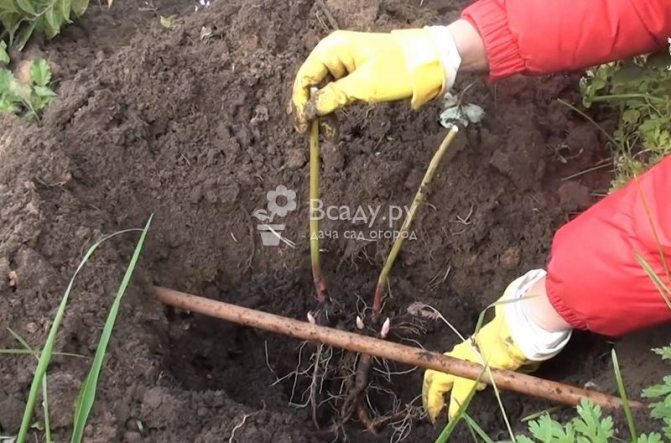

Propagating a peony - transplanting fresh deeds to another place
For the winter, the stems of the seedlings are cut to 10 cm and covered with spruce branches or compost.
If the timing of the transplant of the peonies was chosen correctly, then in the first summer the plant will have bud ovaries. They should be removed so that the plant does not waste energy on the formation of a flower - for the first two years, young peonies will increase the root mass, so you should not get them to bloom.
Terms of autumn plant transplant
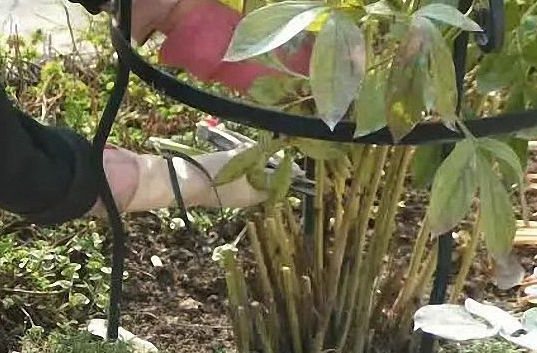

Autumn is the most favorable time for transplanting flowers
Transplanting peonies in the fall to another place is carried out during the period of dying off of the suction roots. This moment falls approximately at the end of August and the beginning of September.
Some gardeners suggest extending the transplant range. But, the fact is that in different regions and climatic conditions, the exact boundaries of the autumn transplant may shift slightly. Therefore, it is better to have time to transplant a peony by choosing the last warm days of summer.
Transplant depending on the type of peony
The recommendations for transplanting described above are given for the most common and unpretentious - herbaceous peonies.
Treelike varieties and Ito hybrids require more respect for themselves. Without special need, you should not disturb the plants.
Tree peonies are transplanted in August-September as well as herbaceous ones. Particular attention must be paid to the gentle extraction of the plant from the soil. The roots of treelike peonies are fragile and reach a length of 80 cm.
- The branches of the bush are tied into a bunch so that they do not interfere with work and do not break.
- The bush is dug in around the circumference, stepping back from the center 40 cm. First, they dig a trench on the bayonet of the shovel, then they take the pitchfork, climbing inward, to the roots.
- Carefully swinging the peony, they pry an earthen lump with roots onto the pitchfork and remove it from the pit.
Advice. So that the earthen lump does not crumble, the day before the transplant, the peony is watered abundantly with water. - In a new planting hole, a perennial is planted in the same way as it grew in the old place, without deepening.
Ito peonies are transplanted using the same technology as tree ones. The most important point in placing a bush in a hole is not to deepen the growth buds.
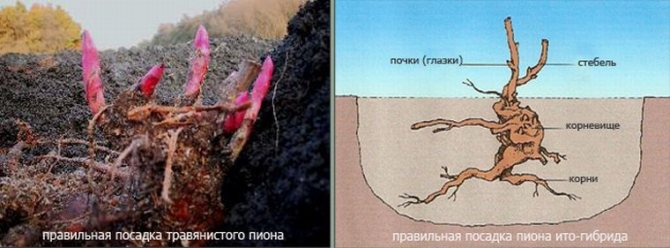

Is it possible to transplant flowers in spring?
Spring is far from the best time to dig up a flower. If the transplantation of peonies in the fall gives a positive result, then the spring work leads to the death of the bush.
The specimens transplanted in the spring remain without suction roots, which break off even with the most accurate transplant. As a result, the plant either dries up or does not give flowers..
An exception for spring work is only young bushes that have not yet managed to create a large root system. But in this case, transplanting peonies in the fall will be preferable.
Spring transplant? When is it best to hold it?
It is extremely difficult to talk about the timing of transplanting peonies in the spring. The optimal timing will vary greatly in different regions. If it is not possible to wait until the fall, you need to pick up the time before the beginning of the appearance of the suction roots. In the Central and Southern regions, this time falls on the end of March - beginning of April.
When to plant peonies in autumn - in what month
It is rightfully believed that autumn is the most optimal period for planting peonies in open ground.
Although some growers plant in the spring, there are several reasons why most often the planting of seedlings is postponed until the fall. Firstly, spring is the time for the intensification of growth, which leads to the depletion of the root system. Secondly, when planting in March-April, you will hardly have to wait for flowering this year.
Note! ABOUT planting peonies in spring read in this material.
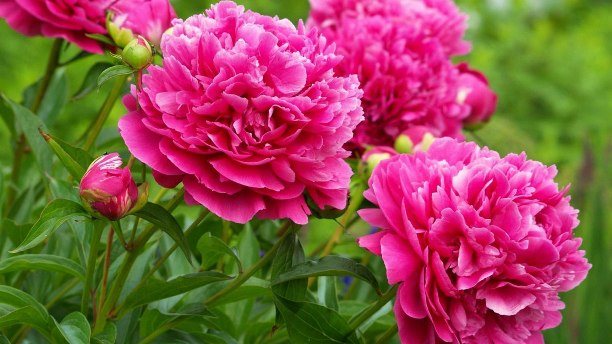

As for the specific dates for planting peonies in the fall, the best time for planting a young seedling in the Central strip (Moscow region) is the end of August-September.
Advice! You need to choose a moment when the summer heat has already subsided, and in the evenings the temperature will begin to differ markedly from the daytime. Moreover, just by the beginning of September, abundant rains come to our gardens, which only have a positive effect on the rooting of young seedlings.
An important point is the planting period - it is required that 30-40 days remain before the onset of winter cold weather. During this period, the shrub grows additional roots and completely takes root in a new place.
If the deadlines for planting a peony in the fall are delayed, then the bush will not have time to take root in time. This will provoke poor wintering conditions, which will lead to a weakening of immunity and frequent plant diseases.
Thus, peonies should be planted in open ground in the fall about a month before the onset of frost. Otherwise, the normal growth of the shrub and its flowering may be absent.
Note! Sometimes it happens that circumstances force the peony to be planted later than the recommended dates (for example, in October-November).
What to do in this case?
- It is necessary to plant the plant in a pot and put it in the greenhouse first. This is done to form the suction hairs on the roots. If they are not there, then the rhizome will not receive water, that is, it becomes dehydrated, and this is very dangerous and has a bad effect on wintering.
- After staying in the greenhouse for some time (2 weeks is enough or if the temperature drops below 0), it is recommended to dig the pot of peony directly into the ground (in winter, the soil freezes in the greenhouse in the same way as outside it).
- Next fall, you can already transplant the flower from the pot into the open ground.
Planting dates for peonies in different regions
Climate features have a direct impact on the timing of planting in different regions.
So, in Siberia and the Urals planting of peonies in the fall is carried out in August and early September. Planting late for optimal growth for the next year will not. Most likely, the bush will simply die when cold weather sets in.
In the middle lane (Moscow region) autumn planting of peonies is carried out from the end of August to the last days of September (although it very often continues in the month of October)... This time is quite enough to take root and prepare for the winter cold. In addition, this climatic zone usually pleases with abundant rains in September, so watering is practically not required.
Naturally, the latest dates for planting peonies in the fall are at southern regions. Here, planting is carried out from October to November. In addition, the mild climate and warm winters make it possible not to shelter young plants.
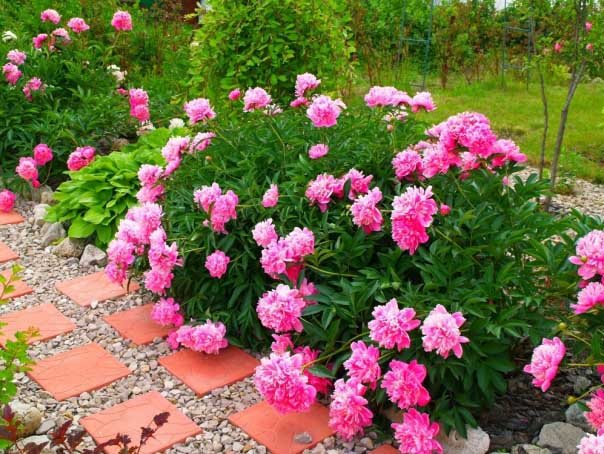

How to care for peonies after transplanting?
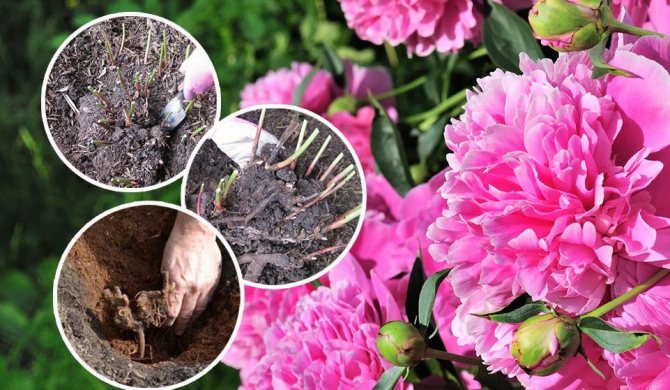

Peonies do not require special care and can be dispensed with with standard procedures.
In the first months after the planting of the cuttings, the root system is actively forming in the flower, the plant is stocked up with food and forms the future bush. Peonies are very unpretentious, therefore, for full development, it is enough to complete a simple to-do list:
- after planting and before the onset of the first frost, 2-3 watering is performed with settled water;
- in the first year, the plants are not fertilized. In the future, a solution of superphosphate and potassium sulfate is introduced under each bush. The solution is prepared at the rate of 1 tablespoon of powder per bucket of water;
- at the end of autumn, the bushes are treated with copper sulfate;
- starting from the second year, peonies must be pruned every year. Pruning is done at the end of autumn. The tops are cut at a distance of 3 cm from the ground;
- in the first year after planting, the hole should be covered with compost or sawdust. Usually 15 cm of the covering layer is enough. Subsequently, peonies do not require shelter, because most varieties tolerate frost well.
The number of buds laid will depend on how comfortable the acclimatization stage was.
Spring transplant
How to transplant peonies in spring so that the plant will recover by autumn and prepare for wintering? It is necessary to remember about timely feeding and proper care of the transplanted bush.
Some professional advice:
- 1Peonies are planted at an air temperature of 10 ° C in a dry, sunny and windless area. Peony roots begin their growth at temperatures above 3 ° C.
- 2 The best soil for growing peonies is loam, but other soils are suitable for the plant besides soils with high acidity.
- 3 Top dressing is applied in stages. In April-mid-May, 50 g of mineral fertilizers of the nitrogen group are applied. At the end of May, potash fertilizers and phosphates are applied. You can replace them with mullein solution. It is prepared according to the recipe: a bucket of manure is soaked in 6 buckets of water. The mixture is left to ferment for 10 days with daily stirring. Before applying under the bush, the fermented mullein is diluted with water at the rate of 2 liters of the mixture per bucket of water.
It is important to carry out foliar feeding of plants in the second season after transplanting. Since the way to plant the bush and feed the peonies on time depends on their rapid rooting in a new place. The abundant flowering of the bush in the next 7-8 years also depends on this.
Foliar feeding is carried out with a solution of carbamide in 2 stages, and stage 3 is feeding with microelements and Heteroauxin.
At the 2nd stage, a tablet of microelements is added to the urea solution. At the 3rd stage of feeding, a solution is made from 2 tablets of microelements and 1 bucket of water. 1 tablet of Heteroauxin is diluted in 3 liters of water. The solution is applied under the roots.
Plants are sprayed with a solution of urea and trace elements in calm weather. The 3 feeding stages are divided into 2 weeks.
For 3 years after transplantation, the plants are fed with mineral fertilizers for colorful and abundant flowering. The nitrogen-potassium complex is applied around the plant during the melting of the snow crust. The amount of feeding is calculated based on the fact that for 1 bush you need 15 g of potassium and 10 g of nitrogen.
At the 2nd stage, phosphates are added during the appearance of buds. Stage 3 is carried out 2 weeks after the cessation of flowering of peonies with complex fertilizer.
Every year, during the budding period, the bushes are watered with a diluted mullein, its recipe and preparation are described above.
Correct transplantation and timely care of peonies allow you to have beautiful abundantly flowering bushes on the garden plot, spreading an amazing aroma around them.
Sometimes it becomes necessary to transplant peony shoots in the spring. This is done after the snow has melted and the ground has completely thawed, you need to have time to make a transplant before the kidneys awaken.
It is noticed that with such a spring movement, the bushes begin to hurt and lag behind in development.
In the spring, during rapid growth, the transplant must be done very carefully. The procedure is no different from what should be done in the fall.
The only caveat: you will not wait for flowers in the first season. When transferring to a new place, it is better to take the rhizome together with a lump of earth.
But many years of experience of specialists suggests that it is still better to replant peonies in the fall.
If the place is chosen correctly, peonies can bloom for more than 30 years.
Tags: spring, when, autumn, transplant, peony
About
«Previous post
Blooming peonies after transplanting
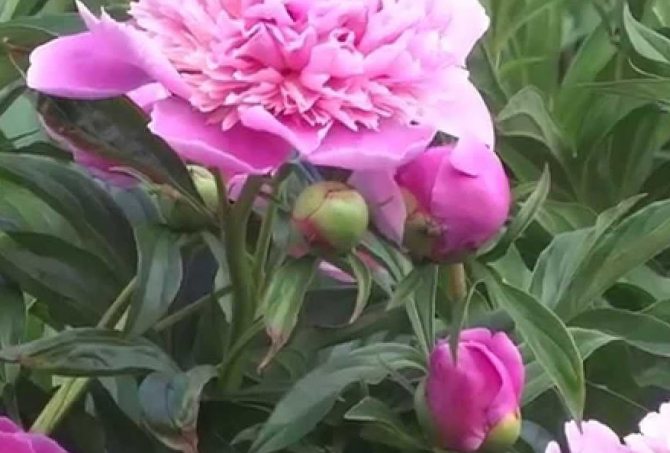

With the right care, flowers won't keep you waiting long.
If the transplantation of peonies was successful, the plant will delight you with lush flowering next spring. As a rule, the bush forms 3 to 5 shoots with flowers. However, experienced gardeners are advised to abandon the first flowering. It is better to remove the set buds at the very beginning. Flowers take most of the nutrients from the plant and do not allow the bush to grow properly.
REFERENCE: "Plants from which inflorescences were not removed in the first spring grow old and depleted much faster."
Separation
When to prune peonies after flowering
Rhizomes of powerful old bushes are tightly intertwined. Therefore, when dividing, they are first measured approximately so that there are 3-5 kidneys on the segments. Too overgrown bushes are divided by driving a wedge into the center of the coma. They work with the roots carefully, despite their impressive appearance, they are quite fragile. They try not to cut off such a fragment where there are many buds and few roots. The plant will not be able to fully feed due to the small volume of the root system.
They adhere to the requirements for healthy divisions:
- root length - 8-15 cm;
- there are at least 3-4 kidneys, but not more than 6-8;
- 3-5 thin shoots depart from the rhizome, up to 8-10 mm thick, up to 4-6 cm long.
The roots are cut with a sharp knife, following the direction from top to bottom. After separation, the segments are revised to reject those where signs of disease are found, or there is large damage. Rotten roots are cut off, treating fresh surfaces, like the entire lump, with copper-based compounds: Bordeaux mixture, copper oxychloride or other preparations. Then the sections are powdered with wood ash. For a day, the planting material dries up in a dry shady corner. To avoid the appearance of rot, the rhizomes are disinfected in a pink solution of potassium permanganate. If desired, gardeners process segments of peony rhizomes in a solution of any growth stimulant, following the instructions for the preparation.
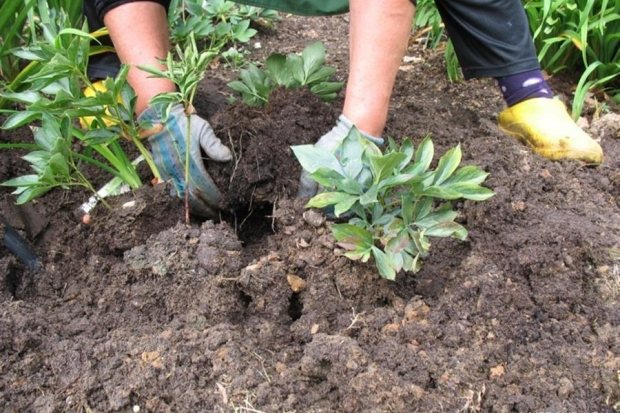

Peony transplant
Undivided bushes take root poorly, so too old rhizomes are cut out from the central part of the coma. In addition, these parts can be rotten or hollow inside. Slices are also processed. You can also plant small pieces of roots, which have 1-2 buds. Experienced flower growers do not refuse from fragments without buds. If there are small, strong roots, the peony will grow into a flowering bush with proper care after a few years. The buds wake up if the rhizome is in good conditions.
Lack of flowering after transplanting
There may be several reasons for this phenomenon. Moreover, many of them can be identified by the appearance of the plant:
Embedment depth... If the peony has grown late and the stems remain thin, it is possible that it is buried too deeply.The best option is deepening the buds by 3-4 cm. With deep embedding, the flowers of the peony will appear, but much later than expected. Insufficient depth will lead to freezing of the kidneys. In this case, there will definitely be no flowers. Shading... Shady spot is the second most common cause. In the shade, peonies practically do not bloom. Small divisions were cut... If there are less than three buds left on the seedling, then the plant will bloom after a few years. Seating too often... Regular division of the rhizome in peonies is not compatible with abundant flowering. Spring transplant... The flower does not have suction roots, and, as a result, there is no strength to form a bud.
Sometimes peonies throw out a bud that does not open. This indicates a lack of organic matter. It is possible that an area with poor soil was chosen for planting. Or there is little fertilization.
At first glance, unpretentious peonies require a lot of patience from the gardener. The first year for this plant is very important. Therefore, when transplanting young bushes, you will have to work a lot on their rooting. But at the same time, peonies are very grateful plants, and will more than reward the gardener's diligence with a lush bloom of luxurious flowers.
Possible mistakes when planting and growing a peony in autumn
Planting peonies is not a difficult task, but rather painstaking. Leaving is also not difficult, the plant is quite unpretentious in this regard. Still, flower growers sometimes make offensive mistakes.
The following typical mistakes can be distinguished when planting a peony in the fall and further caring for a plant in the open field:
- Incorrect planting depth of the seedling. The optimal level of the location of the growth points (buds) of the bush is 4-5 cm. A higher location will have a negative effect in winter, which will lead to freezing of the buds and the absence of flowering (or it will bloom weakly). A significant deepening, on the contrary, will provoke rotting of the buds, because the plant simply does not have enough strength to drive the peduncles to the surface.
- Top dressing in the fall with nitrogen fertilizers. Nitrogen provokes the growth of green mass, which negatively affects wintering. Greens freeze at the first frost, and the shrub loses its immunity, which leads to the freezing of a part of the plant or the acquisition of a disease.
- Low amount of moisture, close arrangement of trees or large shrubs fraught with not only shading, but also drawing out all the moisture after watering from under the roots of the peony. The plant begins to wither and die.
- Shelter for the winter with rotted manure or straw - after getting wet, all the covering material safely begins to rot and rot. Such conditions provoke the acquisition of fungal diseases by the plant.
- Frequent transplanting of a bush from one place to another. Peonies do not like a change of residence. After planting a young seedling, it is not recommended to touch it for 5-6 years, otherwise frequent movements will lead to a lack of flowering.
Important! If you want to cut peonies for a bouquet, then it is worth knowing that in no case can not be cut "on the ground", otherwise the flower bud will simply not start next year. Therefore, you need to count 2-3 leaves from the ground and only then cut it off (and it is better to break it off with your hands).
The interest of novice summer residents either to the peonies themselves, or to the peculiarities of their planting in the fall, does not weaken. This is understandable, because it is very important to correctly determine the timing of planting a plant, a suitable piece of land, as well as choose and prepare a good seedling and skillfully care for a flower dear to your heart after planting.
Video: how to plant peonies in the fall
Landing dates
Preparatory work before planting tubers
Preparation before planting includes site selection, soil preparation and fertilization, and proper division of the mother bush.
Perfect place for peonies
Soil preparation
For planting peonies, soil is suitable, the acidity of which does not exceed 6.5 units.It is optimal if the soil is loamy, but heavy clay soil requires additional introduction of peat, sand and humus.
Since sandy soils are very dry and do not retain moisture well, adding clay, peat and humus will also help to correct the situation. In the soil of this composition, the peonies will be as comfortable as possible, and they will delight you with lush flowering.
Peonies grow worst of all in peat soil, which is practically unsuitable for cultivating these flowers. You can try to improve the quality of such soil by adding sand, organic fertilizers and wood ash.
It is worth noting that it is recommended to prepare planting pits for peonies in advance (about 1-2 weeks). This contributes to the full shrinkage of the soil, which will have a positive effect on rooting. The size of the pit depends on the size of the root system, the bottom is always filled with nutrient soil. Abundant watering will not hurt either - it is optimal to pour 2 buckets of water.
It is optimal when, after preparation, the soil becomes loose, well-drained, and allows oxygen and water to pass through. In such an area, peonies will quickly take root and will feel comfortable.
How to fertilize before planting
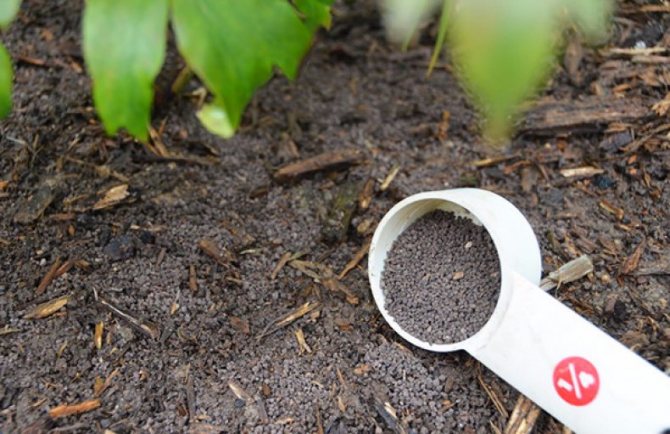

Fertilizing the planting pit before planting will not be superfluous, which contributes to the proper nutrition of the bush. To do this, use:
- 200 g of superphosphate and potassium phosphate, which are mixed with a small amount of wood ash;
- 10-15 liters of a steep solution of manganese (saturated dark pink), which is poured into top dressing.
Laying drainage, which is used as expanded clay, broken brick or small pebbles, will help prevent stagnant water. If necessary, the layer is placed on the bottom of the pit before adding nutrient soil and top dressing.
Division of the mother bush
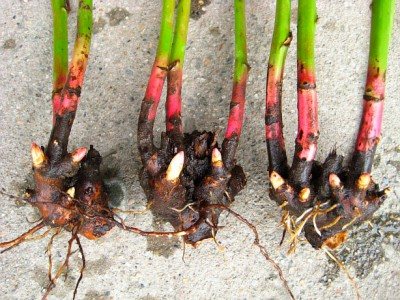

Planting a peony bush is not difficult - for this you need to follow a simple scheme:
- Cut the stems carefully to prevent damage to the flower tissues.
- Dig the bush from all sides, trying not to damage the root system, and raise it above the soil.
- Free the roots from the ground and dry within 24 hours. If the bush has grown a lot, you can divide it by driving a knife or other suitable tool in the middle.
After drying, the root neck of the peony must be cleaned of rot, remove all dried and damaged roots, shortening the healthy ones to 15-20 cm. About 3-5 buds should remain on them. Then the prepared roots are placed for a couple of hours in a steep solution of potassium permanganate, dried and sprinkled with crushed charcoal at the cut points.
Planting material for 1 day is placed in the shade to form a film, then treated with a solution of the drug "Heteroauxin" (2 tablets per 10 liters of water). This will prevent the development of fungal diseases.
Useful Tips
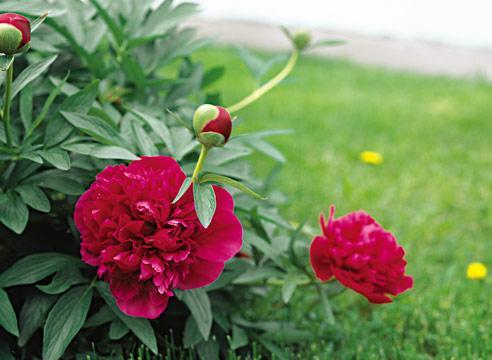

Several recommendations of flower growers that will help to transplant a peony bush more successfully, efficiently and competently.
If the site is located in a lowland, it is necessary to foresee in advance how wastewater will be discharged from the peony bed. We recommend that you dig a drainage groove from the flower bed with the plant so that the water can go along this channel.
In order for top dressing to have a more effective beneficial effect, it is advisable to mix mineral fertilizers with rotted organic matter - weeds taken from clay soil. The benefit of dense clay soil is that it helps to retain beneficial nutrients, while loose sand allows them to pass freely.
We examined the process of transplanting peonies in the garden - as you can see, it is a rather difficult operation that requires preparation and certain skills. However, having carried out this procedure once, in the future you will no longer need the help of useful articles - you will do everything right yourself.
Reproduction
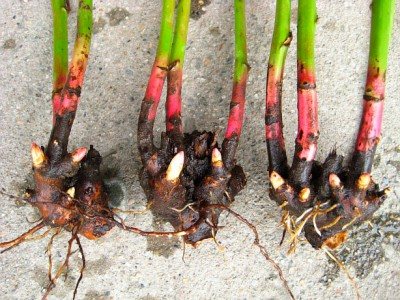

Often the process of transplanting a peony in the fall is accompanied by the division of the mother bush into several parts. In order to correctly carry out this procedure, you need to stock up on the following simple tools:
- a clerical and garden knife (both items must be well sharpened and disinfected with alcohol);
- with a hatchet;
- a small wooden wedge.
The division procedure is as follows:
- the bush is removed from the ground in the usual way;
- drive a peg into its middle;
- knock on the peg, thus dividing the plant into two parts for the beginning;
- with a garden knife, two large parts are divided into smaller ones - it is important that each part has its own roots.
After the division procedure, the peonies are seated in separate holes.
Important: before dividing the plant, carefully examine it and remove all rotten, rotten and damaged parts. This is especially true of the rhizome.
How to transplant correctly
To preserve the flowering of a peony after transplantation, it is important not only to choose the right timing of the operation, but also to carry it out in the least traumatic way for the plant. At the same time, taking into account the characteristics of the flower and providing optimal conditions for adaptation.
Seat selection
Peony is a light-loving subtropical plant, therefore it has special requirements for the planting site. It should be:
- Sunlit for at least 8-10 hours, possibly with light shading for 3-4 hours a day.
- Protected from the wind, but with free air circulation.
- Away from large plants and buildings.
- No close groundwater approach.
- On a hill where water will not accumulate after rains and melting snow.
Peony is good at any time: its carved leaves, beautiful bush shape are attractive. It will retain these advantages even in the case of an inappropriate landing site. However, it will not bloom in the shade and in a draft.
Priming
Peonies grow in any soil. But their beauty is most fully revealed on light loams or sandy loams with a Ph value ranging from 6.0 to 6.8. More acidic soils must be treated with dolomite flour or ash before planting.
The soil is prepared beforehand, at least 2-3 weeks in advance: from garden soil, sand, peat and humus in equal shares
For this:
- The soil is dug onto the bayonet of a shovel, carefully selecting the weeds.
- Organic matter is introduced - rotted compost, leaf humus. The introduction of manure or poultry droppings leads to the appearance of spots on the leaves and a decrease in the plant's immunity to fungal diseases.
- Dig holes 60x60 cm in size.
Transplant technology
If you plan to plant several bushes, place them at a distance from each other:
- undersized varieties - at least 70 cm;
- medium height - up to 110 cm;
- tree-like - 150-180 cm.
Drainage is laid on the bottom in each pit - broken brick, expanded clay, pebbles. The "heavier" and damper the soil, the higher this layer should be - up to 20 cm.
Then the prepared soil and fertilizers are poured:
- 200 g double superphosphate;
- 1 tbsp of ferrous sulfate (or bury 2 cans);
- 0.5 tbsp potassium sulfate.
The soil mixture in the pit is mixed, watered and left to shrink.
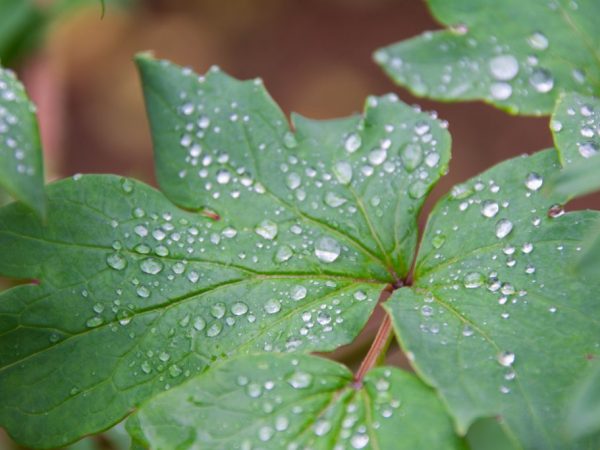

Peonies have a very vulnerable root system.
The root system of the peony is very delicate, vulnerable, so the transplant procedure must be performed with the least damage to the rhizome.
For this you need:
- Dig in a bush in a circle at a distance of 40 cm from the stems;
- Insert the forks into the dug groove and loosen the bush so that it can be easily removed from the ground;
- Carefully loosen adhering soil. Never shake or knock on a hard surface! If it is necessary to divide the bush, then the small roots can be washed under a gentle stream of water;
- Leave to dry for several hours;
- Remove all diseased, damaged and dry roots with a sharp knife;
- Shorten the shoots to 20 cm;
- Divide the rhizome (if this operation is needed) so that 4 buds remain on each division;
- Dip the roots of the plant in a fungicide solution, then soak in a root-forming solution;
- Sprinkle the cuts with crushed activated charcoal, potassium permanganate or garden pitch.
A cut is placed in a pit with a ready-made soil mixture so that the root collar is at a depth of 5-7 cm. Fill in the rest of the soil, compact and watered abundantly - at least 5 liters of water for each bush.
Note! Young buds must be covered with earth, otherwise they will dry out and die. But too much deepening will lead to decay and cessation of flowering. The optimal soil layer above the buds is 3-5 cm.
Why there may be no flowering after transplant
Plants separated in autumn take root well, but begin to bloom only for 2-3 years. If the cuttings have not bloomed for 3 years, then the planting material is divided very finely. You need to wait until the bush gains the required volume.
Correctly transplanted peonies without division are capable of blooming the next year. If this did not happen, then there may be several reasons:
- too acidic soil;
- planting depth more than 7 cm or less than 5 cm (with a deep one - the kidneys will rot, with a shallow one - they will freeze);
- there is an excess of nitrogen fertilizers or organic matter in the soil. The bush spends energy on increasing the green mass, and not on flowering;
- lack of moisture during the laying of flower buds;
- leaves and stems are cut immediately after flowering. They did not participate in the process of photosynthesis and did not transfer the necessary energy to the roots;
- the peony is damaged by diseases or pests.
Preparing for winter


Peonies are quite frost-resistant plants and do not need special shelters for the winter. The only measure in case of insufficient snow cover, in which the roots may suffer, is mulching the soil with straw, sawdust, dry leaves. You can cover the area with spruce branches. In the spring, the shelters are removed immediately after the snow melts. It is impossible to delay this process, since it will be difficult for the shoots to break through to the surface, and the development of the bush will slow down, flowering will come much later.
Important! Cut peony stems should not be used as a shelter, since pathogens or pests that attack the bush in the next season can remain in them.
A competent choice of time, a place for planting a peony and adherence to technology will have a beneficial effect on the condition of the plant. In the spring, the bush will quickly begin to release shoots and will soon delight you with a bright and lush flowering.
Processing peonies in the fall from diseases
It is not for nothing that the article examined in detail how to propagate peonies in the fall, since it is this period that significantly affects the health of plants and the degree of resistance to diseases. So, peonies have strong immunity, then they tend to get sick from time to time. Therefore, the treatment of peonies in the fall from diseases and parasites is required, as well as throughout the growing season.
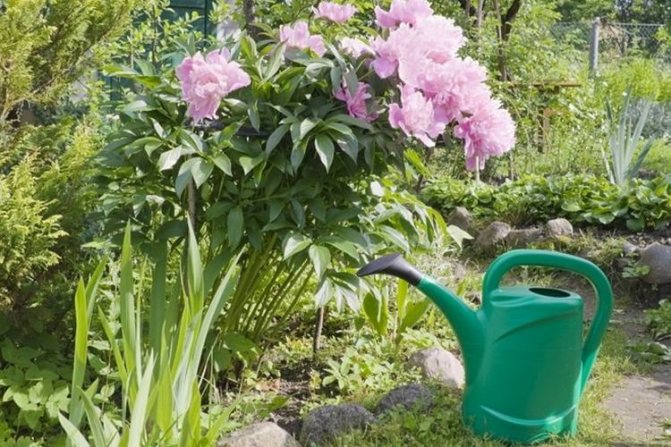

Processing peonies in the fall from diseases
More often, the culture suffers from lesions of the fungal genus, but viral pathologies also occur. Many of them pose a serious threat to the decorative appearance and longevity of plantings. The most common:
- ring mosaic;
- rust;
- brown spotting;
- gray rot;
- botrytis.
There are not so many dangerous insects, mainly: aphids, caterpillars, ticks, thrips. Soil pests are distinguished: nematodes, caterpillars-scoops, sod ants, bronze.
How to treat peonies for diseases in the fall:
- systematic treatment with Bordeaux liquid or copper oxychloride helps from gray rot, the concentrate of which is diluted in an amount of 50 g per 10 liters of water;
- rust is defeated by the same Bordeaux solution or colloidal sulfur, with the addition of liquid soap.
For the sake of prophylaxis during division, transplanting, the roots and the leaf component are disinfected with manganese infusion, Bordeaux water or any fungicidal preparation (prepared according to the attached instructions). The same means are watered.
In late autumn, overgrown herbaceous varieties are shortened to the base in order to exclude the possible spread of the disease from diseased shoots. Wood ash, which is used to powder the slices, will serve as an antiseptic.
How to dig a peony correctly
And at this stage you will have to make a lot of effort, especially if the peony has not been transplanted for a long time and has grown greatly. Dig in the bush from all sides, stepping back 25-30 cm from the base of the extreme stems. So that there is no temptation to pull these stems and pull out the bush, cut them off, leaving stumps 15–20 cm high. Still, it will be convenient to hold onto them during the division of the rhizome and planting. If you pull strongly on the stems while digging, then they will come off along with the replacement buds at their base, and these are the main generative organs of the peony.
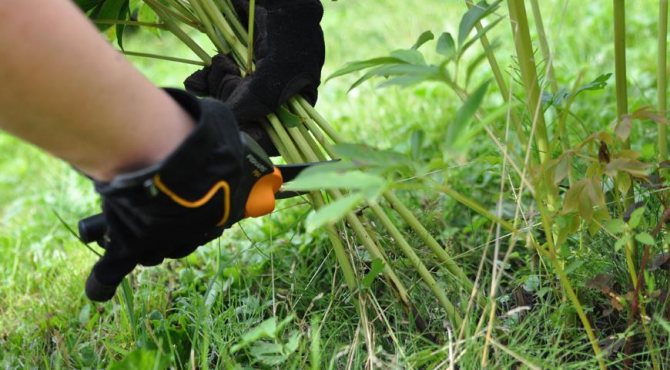

Do not pull the bush by the shoots, cut them off
Swing the bush dug on all sides with a shovel or pitchfork, rake loose soil from the base, without it, it will be easier to remove the rhizome. After that, put a shovel or crowbar under the root and, acting as a lever, lift the bush. If it does not work out, there is not enough strength, the bush is too powerful, then drive a wedge or crowbar right into its center. Then the root will crumble into pieces.
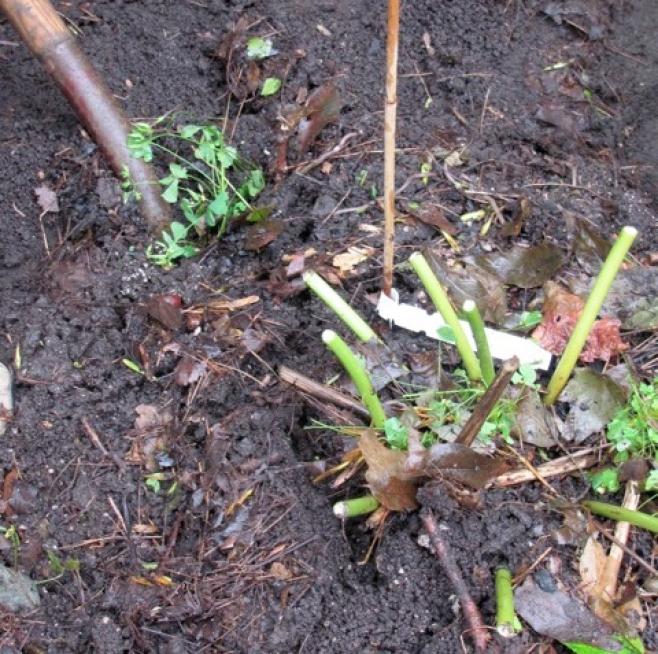

Use a shovel or crowbar as a lever
Digging and dividing a peony is always accompanied by significant damage to the rhizome, there will be many debris and wounds. Get ready for this mentally, but try to cause minimal damage to the plant as much as you can.
The root taken out of the ground must be cleaned. Shake off the soil as much as you can with your hands, and then rinse with a hose or in a basin of water, a bucket, an old bath, etc.
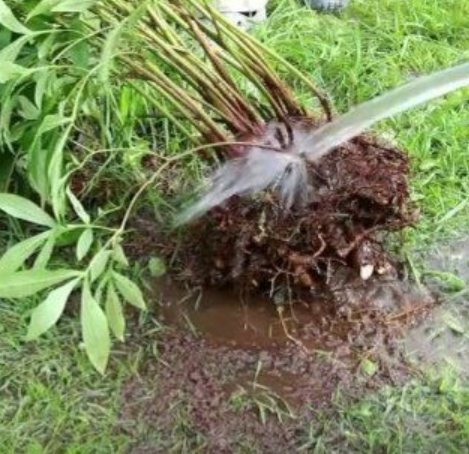

Rinse the roots, otherwise you will not understand what and how there can and should be cut off
With a lump of earth, only seedlings of peonies from the nursery, grown in pots, are planted, and then it is advisable to shake off the ground and check the roots for rot and other damage.
Remember
- Choose a healthy seedling. Dried roots affected by rot, which do not have growth buds, do not need to be planted - these are diseased plants.
- Find the best place. In deep shade, the peony will not bloom. Plant on sunny areas where sunlight lasts for at least 7 hours.
- Observe the rules of planting and care. Planting a peony should be carried out in a prepared hole with fertile soil. Feed on time in the spring or 2 times in the summer.
From experience I realized that autumn planting is the best for peonies and always gives good results.
Soil for planting peonies
Dig up the site with the introduction of everything necessary, in advance. When planting, pits for peonies are filled with soil substrate layer by layer, and each has its own purpose, and, therefore, a different chemical composition. The laid base serves as food for the rhizome - it takes up most of the volume. Its thickness is 12-15 cm. For it they mix: organic matter (rotted compost and manure), mineral complexes, wood flour, garden soil.
Sandstone is diluted with clay lumps, clay - with perlite. In the regions of the middle zone and in the North, it is advisable to add lime to lower the acidity. The nutrient composition is poured onto the bottom of the hole and thoroughly trampled underfoot.
The subsequent layer of soil protects the plot from negative external factors and protects it from the development of a fungal environment, which leads to various kinds of diseases. It should be breathable and breathable. The most suitable option is loam, with an acidity index of 6-6.5 pH. Of the fertilizers, only ash and dolomite flour are added to it (a glass of each).
Seat preparation
When a suitable site for transplanting peonies is determined, they begin to prepare planting sites for plants, while it is immediately worth planning the frequency of holes - one per 2 m2. With this planting, maturing peony bushes will have enough nutrients for many years.
Important! If the planting of a peony in the fall is done according to all the rules, flower buds in the spring will appear 2 weeks ahead of schedule.
It is recommended to prepare planting holes for peonies when planting in autumn 1.5-2 months before the start of work. During this time, the soil should be saturated with useful substances, compacted and settled.
For planting hybrid plants for a long time without planning quick transplants, you should prepare pits with dimensions:
- Depth - from 60 to 70 cm.
- Width - from 80 to 100 cm.
For ordinary peonies, when planting for 2-3 years, a hole with dimensions of 45x45x40 cm is enough. This is how bushes are planted for which a permanent place has not yet been selected.
A considerable distance should be left between the plants (at least 90 cm), for each bush it is necessary to take up to 2 m2 of garden area. With such a planting, the plant will be able to freely form a powerful root system; there will be free space between individual bushes, which is necessary for air circulation.
Important! Free planting of peony bushes prevents the development of fungal and other infectious diseases.
The planting depth of peonies in autumn should not exceed the soil level by 2o-30 mm. Too deeply buried plants develop poorly, which negatively affects growth and annual flowering. The high location of the bush in the planting pit can cause freezing of the root system and the death of the buds.
Important! If a high level of soil water is observed over the entire area of the site, the plants are planted on ridges so that the distance from the surface of the poured layer to the groundwater is at least 0.7 m.In this case, the depth of the pit should not exceed 40-45 cm, and its sides can be up to 80 cm.
Peony bushes transplant technology in autumn
Peonies grow well in open, well-lit places, protected from sharp gusts of wind, but with good circulation of air masses. Most preferred would be an area that is slightly shaded during the hot afternoon hours. Best of all, these flowers grow on permeable, loose and fertile soils with a close to neutral alkaline reaction (pH not higher than 6–6.5).
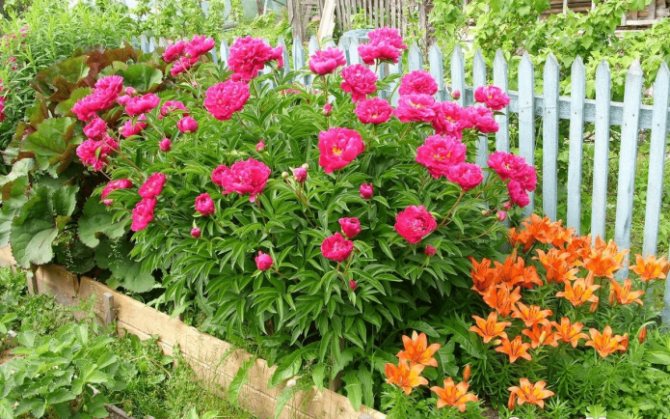

Peonies love well-lit sunny places.
The most suitable for peony will be light loam and sandy loam. Heavy wet soils are diluted with sand, clay is added to sandstones for better moisture retention.
A place for planting peonies should be prepared in advance, about 2-3 weeks in advance, so that the earth settles:
- A hole is dug with a size of 0.6 * 0.6 m and a depth of 0.7-0.8 m.
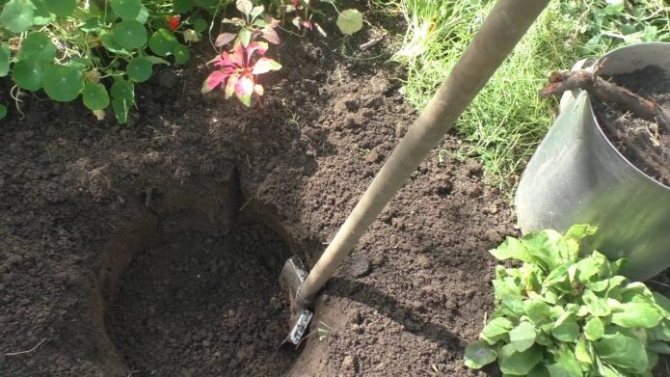

The pit for the peony should be large enough, as its roots grow strongly
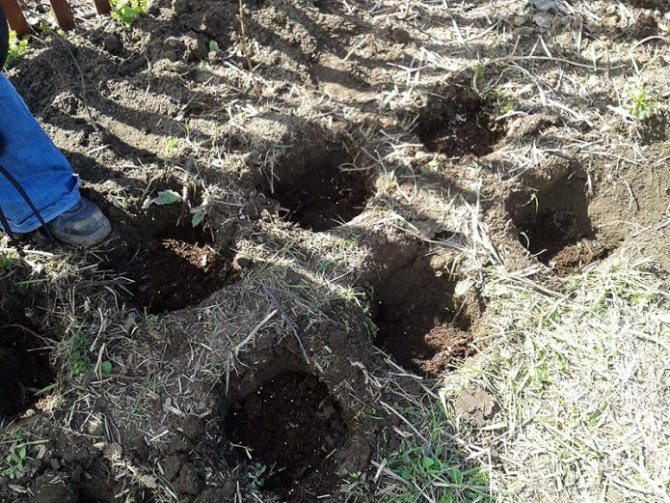

Pits for small peonies are made at a distance of 0.8-1 m from each other
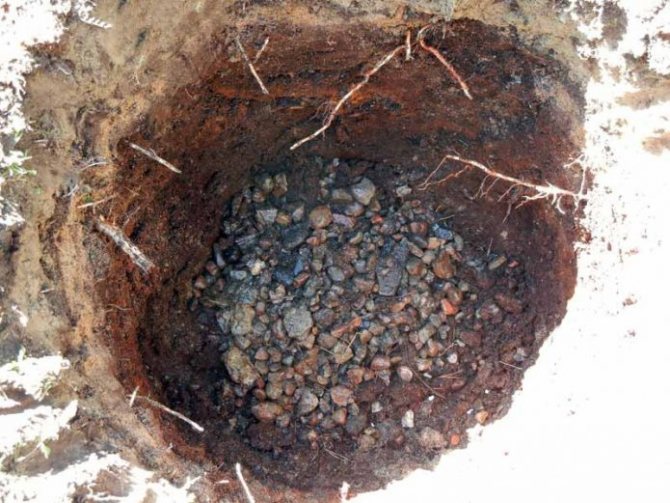

Drainage from stones, pebbles, broken bricks, etc. is laid at the bottom of the pit.
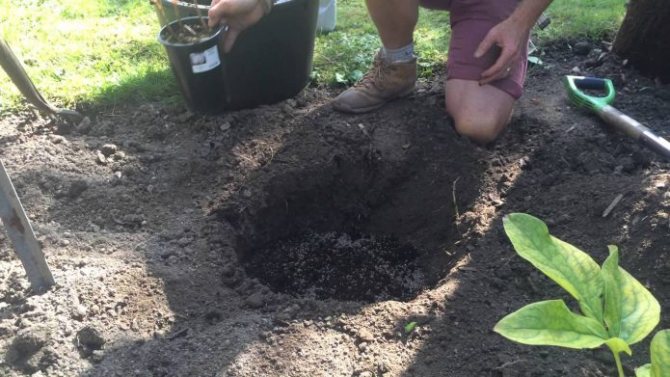

The planting pit is 2/3 filled with soil mixture
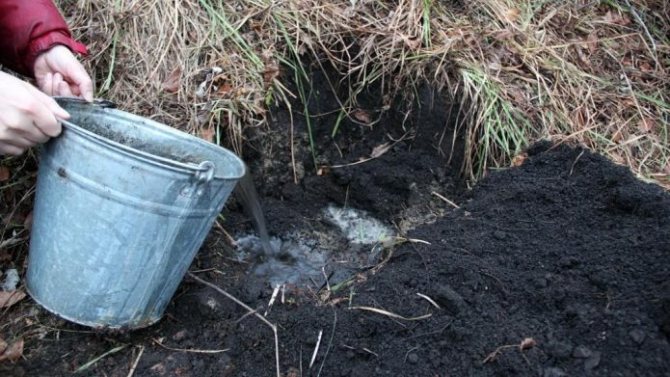

The soil mixture in the planting pit is spilled abundantly with water
For planting, use purchased seedlings or divide the existing mother bushes of peonies:
- All stems are shortened to 10-15 cm.
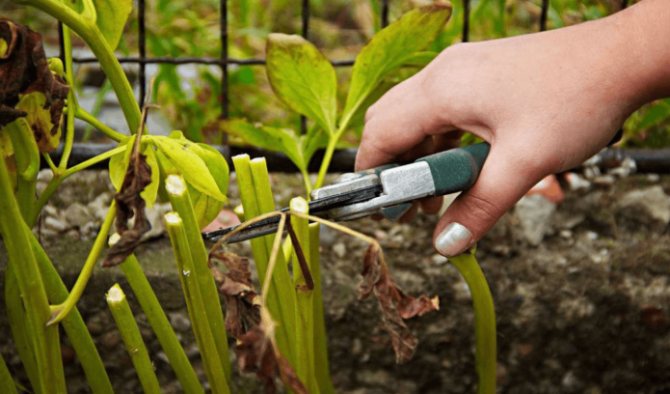

Before transplanting, you need to shorten the stems of the peony.
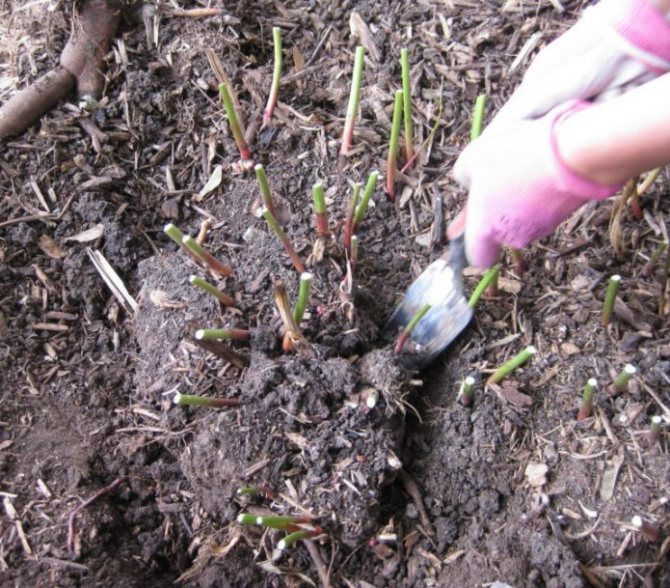

First, a peony bush is dug around the perimeter
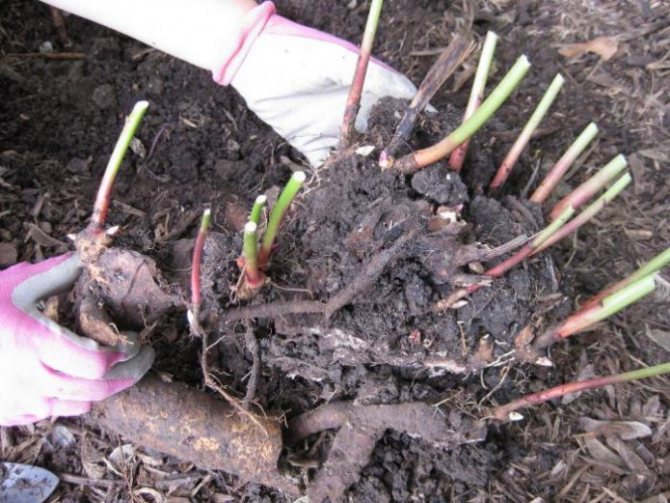

Peony bush is extracted from the ground
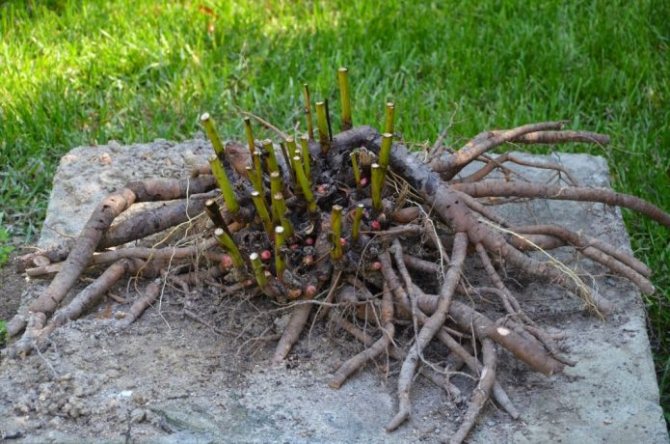

The dug out peony bush is left to lie in the shade so that it wilts a little and the roots become not so fragile
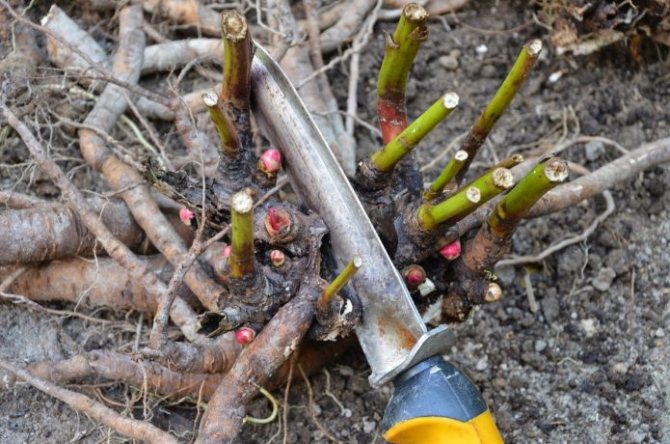

The peony bush is cut into pieces with a sharp knife.
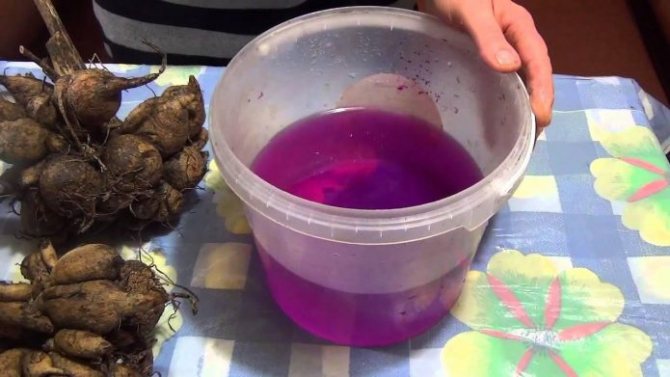

First, the rhizomes are disinfected in a strong solution of potassium permanganate
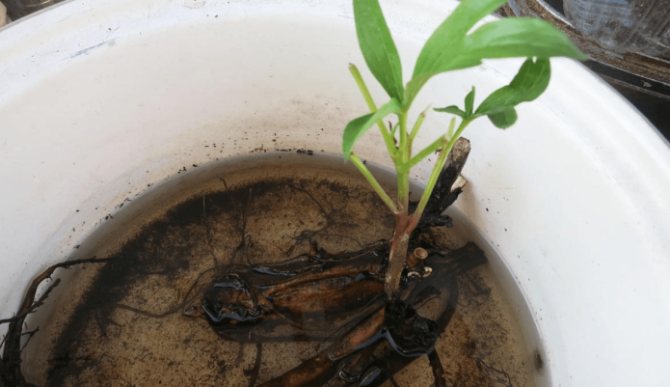

Then the rhizomes of the peony are soaked in a solution of a root formation stimulator
The procedure for transplanting and dividing is extremely painful for plants, therefore it is carried out only when the bush has grown too large and needs to be planted.
Next, proceed directly to planting:
- The seedling is placed in the prepared hole. It is necessary to ensure that the growth buds are 3-5 cm below ground level.Excessive deepening with dangerously increased leaf growth and poor flowering, if located close to the soil surface, freezing of renewal buds is possible.
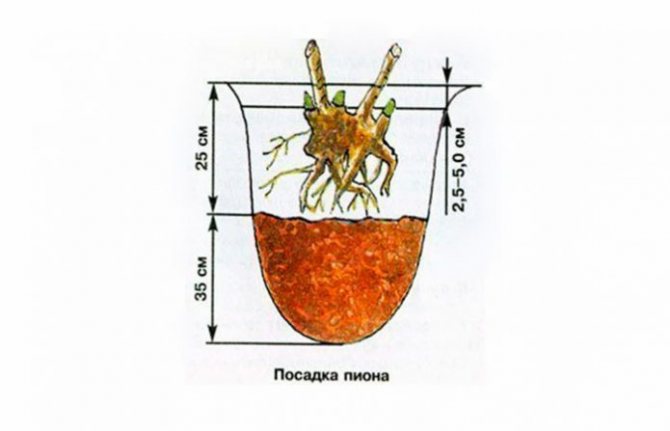

We arrange the peony bush so that the buds are 3-5 cm below ground level
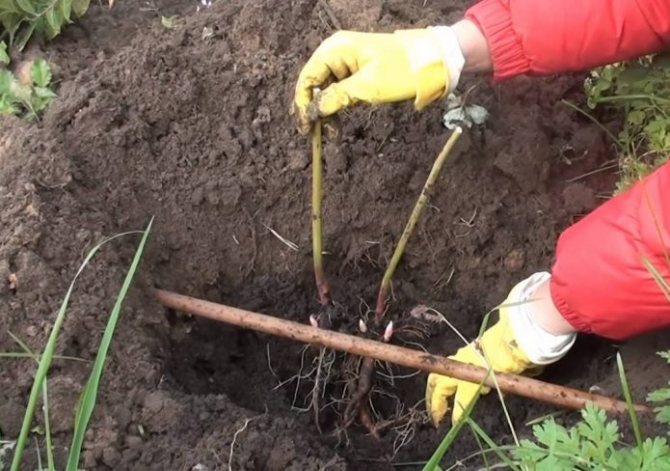

We gently straighten the roots and lay them along the bottom of the pit
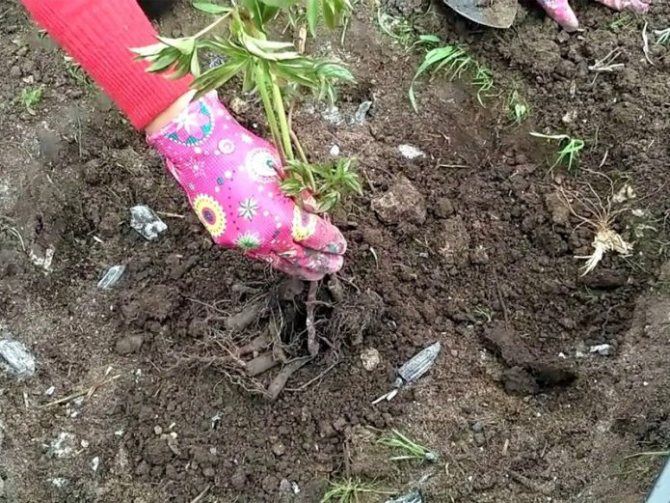

Holding the bush in weight, fill the planting hole with earth
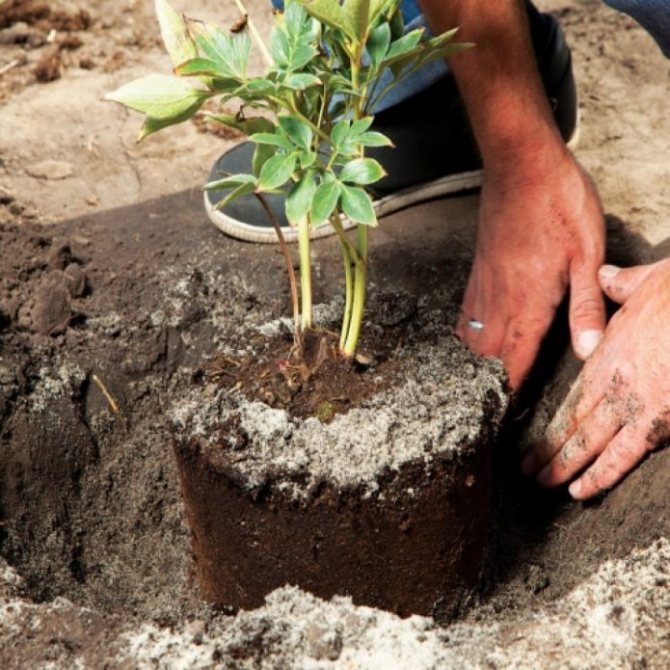

The ground in the pit must be well tamped so that voids do not form
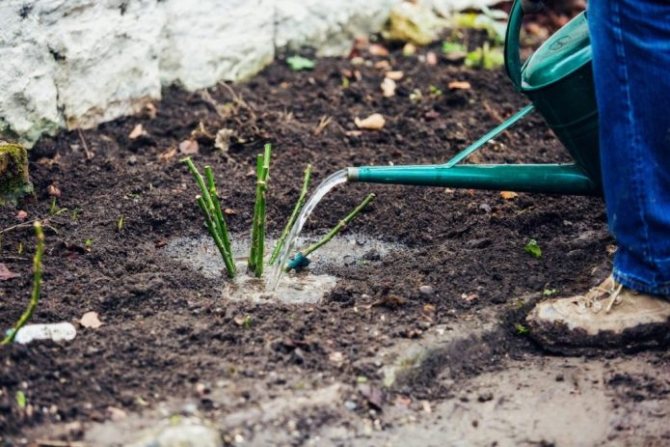

After planting, the seedling needs to be watered well.
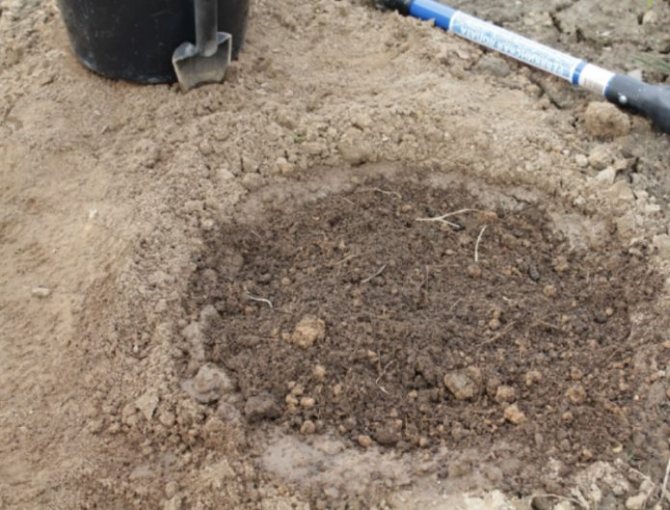

Peony is mulched with humus or peat
Planting tree peonies is carried out in a similar way, with the only difference that the root collar deepens slightly lower (8–10 cm from the soil level).
Choice of location, best predecessors and neighbors
Peonies grow well and bloom only in sunny places, without stagnant melt and rainwater. With excess moisture, succulent roots easily succumb to putrefactive fungi. The best predecessors are legumes, as well as crops that you fertilized and fed well in the current season (cucumbers, zucchini, pumpkins, tomatoes, cabbage, etc.). You can not plant peonies after the same perennials that have depleted the soil for several years in a row.
Ornamental plants with other flowering periods will become good neighbors: crocuses, tulips, daffodils, lilies, asters, chrysanthemums. You should not plant nearby actively growing shrubs and seedlings, which in 1-2 years will begin to shade peonies.
How to plant peonies in open ground
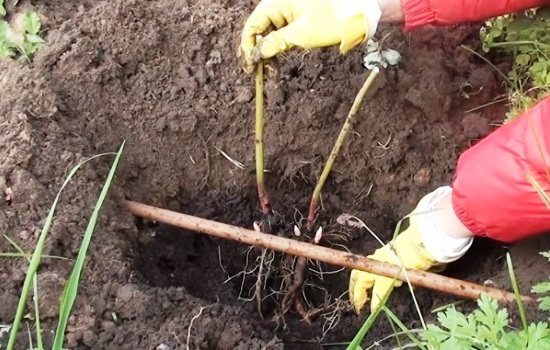

In autumn, planting peonies is necessary in several stages:
- A layer of coarse-grained river sand is poured into a hole prepared in advance, the thickness of which should not exceed 20 cm.
- At the bottom, it is necessary to form a small mound, where the peony itself is placed. The root system must be evenly straightened along the hole.
- Be sure to control the deepening of the growth point - they should be about 5 cm below ground level.
- The voids are filled with nutrient soil, while the plant must be squeezed from all sides, forming a hole for watering.
- After the end of planting, the bush is abundantly watered and mulched with rotted manure or compost.
Further care of the bush consists in moistening the soil, if necessary, as well as weeding and loosening the beds. Fertilizers can be applied 2-3 years after planting, and it is better to cover it with a layer of mulch for the winter every year if there is a risk of soil freezing.
It is possible to transplant and propagate perennial flowers, including peonies, in spring, autumn and, in rare force majeure situations, even in summer. How successful the process will be depends on the timing, correctness of the work and subsequent care. This article is intended to help the gardener understand the intricacies of the process and choose the right time for planting autumn peonies in the ground.
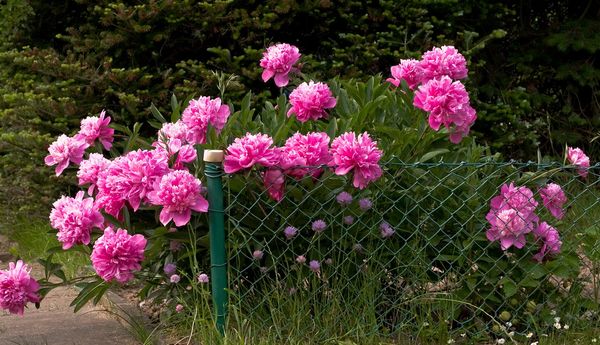

With what to plant peonies in a flower bed
A person who strives for harmony and beauty in the garden, for sure, may have a logical question - with what can you plant peonies in a flower bed? To make flowers look the most advantageous and beautiful, they should be planted next to suitable plants and according to the rules of landscape design:
- The important point is the color combination. You should not plant a peony in front of or next to flowers of the same shade if they bloom at the same time (red with red, pink with pink).
- It is also important what kind of flowers you plant next to the peony. Irises, delphiniums, lilies, bells, daisies, clematis look harmoniously. But they should have contrasting colors so as not to merge and mutually drown out the beauty.
- An even green lawn or just green grass looks appropriate between flowers.
- Flowers look great against the background of large trees and shrubs, including against the background of juniper and thuja.
- Excessive proximity with other colors is not recommended, as they will interfere with normal care.
The photos below show options for placing peonies in a flower bed with other flowers and plants:
Dividing a bush when replanting: a step-by-step guide
If the root is too juicy and brittle, leave it outdoors after washing. Water will drain from it, it will become frayed, wither and become more elastic. In the meantime, study the location of the shoots, buds and interlacing of the rhizomes, find jumpers that can be cut. It is recommended to divide so that 3-5 replacement buds remain on each part, as well as juicy rhizomes on which they formed.


You have to divide a large root into such divisions with three buds, the remainder of the shoot and a juicy rhizome
Young roots will break in thin places (bridges) right in your hands, you just have to move slightly or make a little effort. The old ones are cut with a knife with a sharp and thick blade, and sometimes they are cut with an ax.
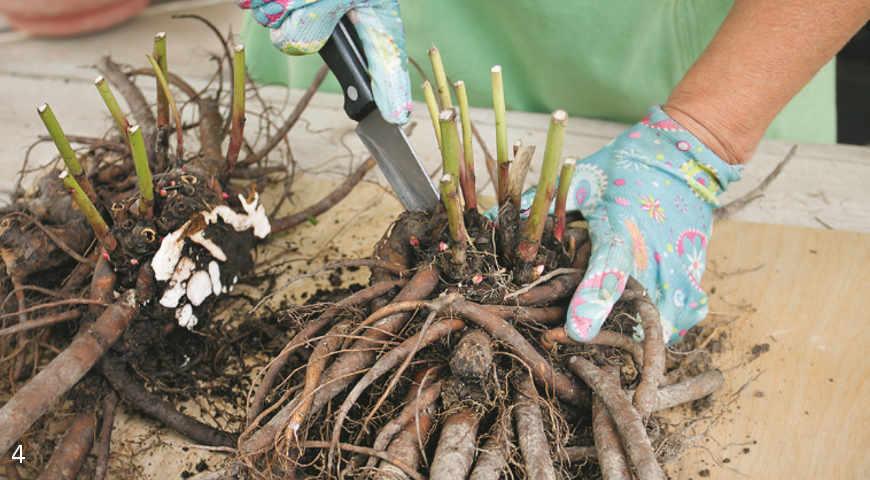

A large and old root is cut with a sturdy knife
If, as a result of manipulations, in addition to divisions with 3 or more kidneys, they are also obtained with one or without them at all, then such can be planted. There is a chance that they will sprout, but weak, the bush will bloom for 3-4 years.
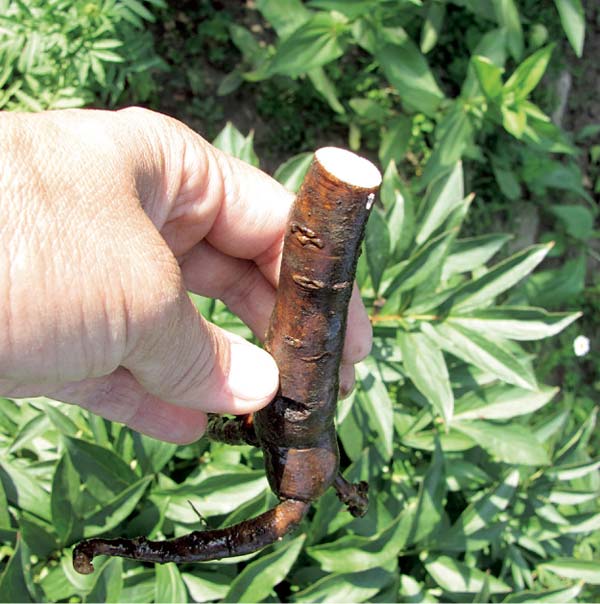

A root without buds (eyes) is called blind, it can also be planted
When is it better to transplant - in autumn or spring
Many flower growers are in thought, deciding when it is better to transplant peonies - in the fall or still in the spring. Note that both periods can be a suitable time for the procedure - however, autumn and spring transplants have their pros and cons.
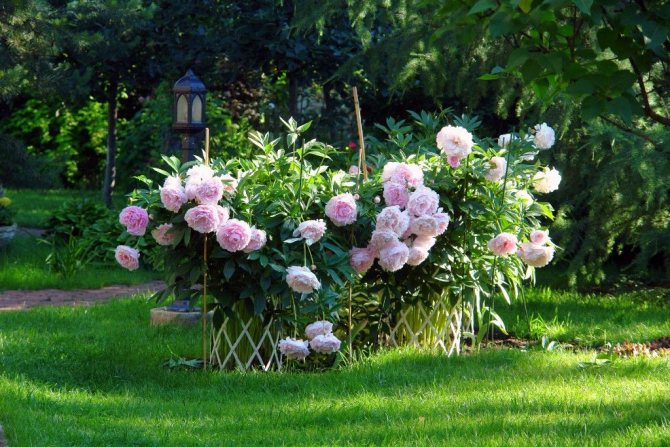

Spring
If you carry out the procedure in the spring, then in the current season of flowering peonies can no longer wait. This is due to the fact that plants adapt for a long time, get used to a new place - therefore, it will be possible to enjoy the view of a flowering peony bush next year, or even only after a couple of years.
In addition, with a spring transplant, it is very important to have time to carry out the procedure on time - before active vegetative processes begin in the plant, sap flow begins. If you do not have time, then it is better not to start, since the peony that has begun the growing season tolerates the procedure very hard.
The period suitable for a spring transplant is rather short. It is necessary to meet the deadline from the moment when the snow completely melted, and the air warmed up to +7 degrees until the moment when sap flow begins in the plant
Another minus - the spring transplant excludes the possibility of pruning the bush, as this is additional stress for the plant. But it is in the spring that it is necessary to remove old, frozen and diseased branches, not to mention the need to form a bush.
Important: in spring, peonies are not divided, but transplanted exclusively with a whole bush. Reproduction is carried out only when transplanted in the fall.
Autumn
This is the most suitable option for a transplant. In what month is it best to carry out the procedure: the best option is the end of August-beginning of September. Flowering has already ended and young roots have grown on the mother plant, which are able to actively absorb nutrients from the soil.
As mentioned above, the autumn transplant makes it possible to enjoy the flowering of the peony bush next year. In addition, plant survival and adaptation are much higher and better in autumn than in spring. The transplant procedure is much less traumatic for a peony.
Summer
Sometimes peonies are transplanted in the summer - however, this is usually done by beginner flower growers. The survival rate in this case, the bush is even worse than with the spring transplant, and the tolerance of the procedure is very low. In addition, flowering may not come for the next three years.
Another significant minus - with a summer transplant, there is a high risk of completely destroying the plant, since the peony roots can die from sunburn, overheating, damage.
Content
- Listen to the article
- Description
- Planting peonies When to plant
- Planting in autumn
- Planting a tree peony
- When to transplant
- Watering
Pick-up location
- The most important thing: to assess the prospect of a long life of a peony in a chosen place (for some varieties, the residence time can be 50 or more years);
- The best landing site is on virgin soil;
- Eliminate areas near the roots of trees, shrubs and other large perennials;
- Avoid unfavorable predecessors: trees, shrubs, large perennials and especially peonies;
- The place should be sunny or partially shaded for 5-6 hours, preferably at noon. In the southern regions, partial shading is advisable for all varieties, especially dark-colored ones.
- Areas that are permanently flooded by spring or storm water are unsuitable.
- The planting area must have a water drain.
- The groundwater level should be 70-80 cm below the soil surface, and for plantings for more than 7 years - 100 cm.
- The landing site should be protected from winds and located at a distance of at least 1-1.5 m from the walls of the house and solid fences.
- The optimum acidity of the soil is neutral or slightly alkaline with an acidity index of pH = 6-7.5.
Care after landing
Immediately after excavation, mulch the planting pit with peonies with peat. If, for one reason or another, contrary to the recommendations, you were forced to plant flowers in the spring, be sure to treat the foliage several times with drugs that help to survive stress (epin, zircon, megafol).
Advice! It is very useful for spring planting to water peonies with drugs that stimulate the development of the root system (root, heteroauxin).
Autumn planting - less stress for the flower. It is enough to cut the foliage, mulch the planting circle and if there is no precipitation at all in the fall, carefully moisten the soil several times.
Important! Although a peony is a flower that is better to underfill than overflow, after you plant a bush, be sure to make sure that the soil does not dry out until it is completely rooted.
Planting peonies in autumn
The seedlings bought in pots are not taken out, but planted with them. Only pre-moisten abundantly so that the roots are saturated.
The sequence of planting autumn works applicable to divided rhizomes of herbaceous peonies:
- A hole is dug to a depth of 60-70 cm and a width of 45-50 cm. Drainage (9-10 cm) is laid from below: broken brick, clay shards or gravel.
- The next layer will be a nutritious soil mixture prepared according to the recipe given earlier. A hill is formed from it, on which a peony plot is placed. The root branches are neatly distributed over the free internal space.
- Fill up with soil, extracted during digging, with some minor inclusions (dolomite flour, ash). In this case, the seedling is held with one hand. It is important that the root collar goes underground 5-6 cm from the surface.
- At the end of the procedure, channels are made in the root zone, where 1-1.5 buckets of water are poured. If after that the soil subsides, then the original state is restored by pouring.
- The final touch will be mulching with peat or mullein.
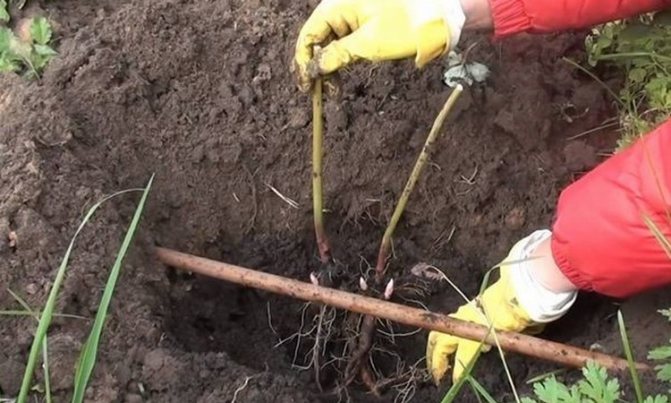

How to propagate peonies in the fall
Planting tree peonies
The algorithm of preparatory measures for planting tree-like peonies is the same as for herbaceous ones. Only the hole is dug out more spaciously and deeper - 70x70 cm. The seedling is set so that the ovaries on the shoots are outside, and the starting point of growth is drowned by 10-13 cm. Immediately drive in a vertical support that will support the landing. After backfill, water well and spread the mulch.
Sanitization after digging and dividing
Rot fungi like to settle on juicy cuts, they disrupt the nutrition of the root from the ground, the bush will ache and wither. To prevent this:
- Immediately after digging and washing the rhizome, check if there are any voids in it eaten by mice; wormholes inflicted by insect larvae; rot and other damage. Cut out all diseased parts to a healthy white cut.
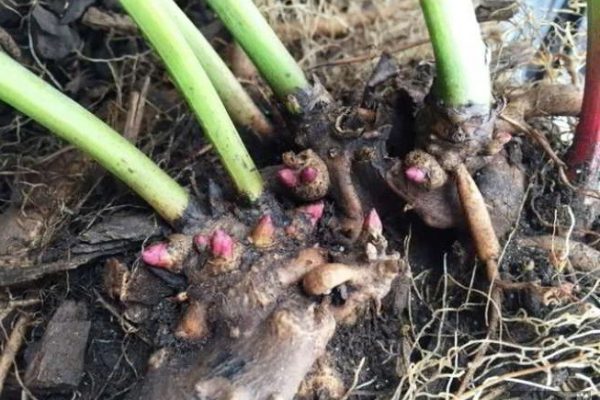

In the center of the rhizome, a void is visible, most likely eaten by mice. - Align all cuts and breaks. They should be smooth, not torn.
- Dip the rhizomes in a pink potassium permanganate solution for 20-30 minutes.
- Well sprinkle the wounds with charcoal or activated charcoal, you can grease it with greenery or let it dry in the air.

